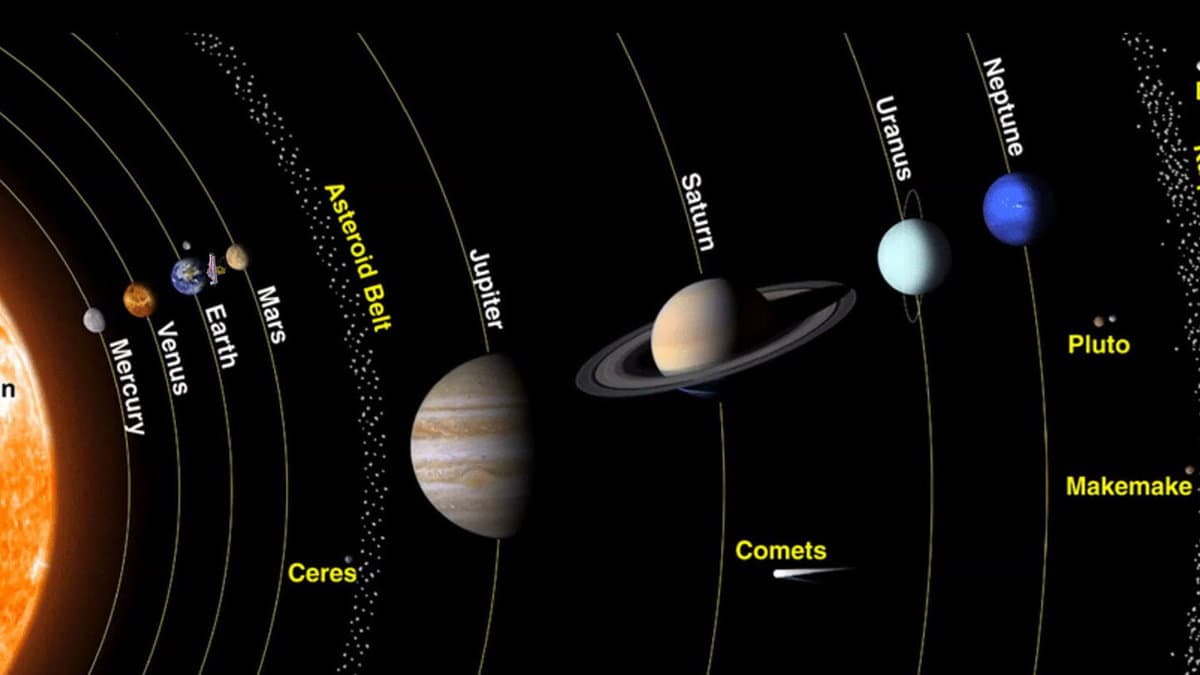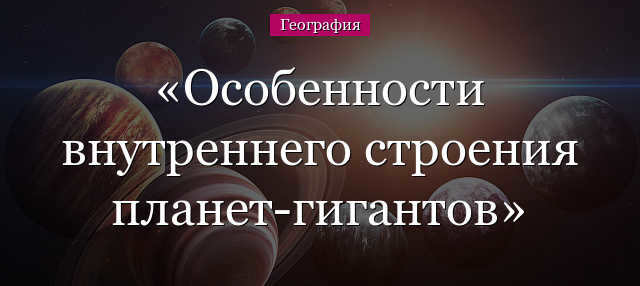
Giant planets are a category of massive planets that lack a solid surface. These celestial bodies are frequently accompanied by numerous satellites. The Solar System contains four giant planets, namely Jupiter, Saturn, Uranus, and Neptune. These massive entities rank as the largest objects in our solar system, second only to the Sun. In this article, we will briefly explore the distinctive characteristics of the internal composition of giant planets.
Lack of a solid ground
The primary distinguishing characteristic of the colossal planets is the lack of a solid ground. They are immense orbs, primarily filled with gases. That is why colossal planets are often referred to as gas giants.
Even when humanity fully explores space and manages to reach their nearest neighbor, Jupiter, they still won’t be able to walk on the planet’s surface simply because it consists of gases.
At greater depths, the atmosphere of the colossal planets becomes denser and undergoes a transition from gaseous to liquid state. Unlike Earth, gas giants lack a distinct boundary between the ocean and the atmosphere. The ocean itself is composed of liquid hydrogen rather than water.
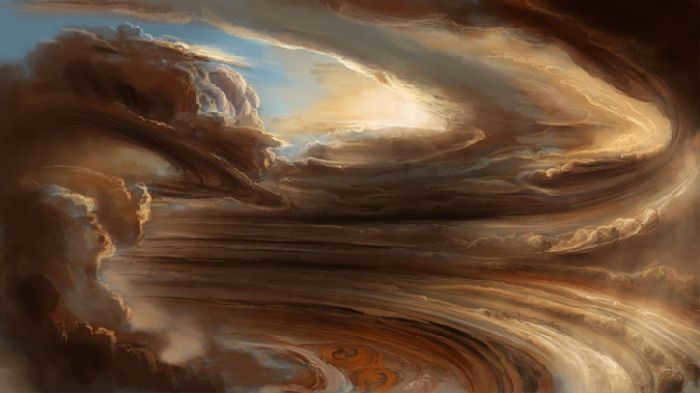
When approaching the core, the pressure within the colossal planets intensifies to the point where hydrogen adopts a metallic structure. This state of matter cannot be achieved under normal terrestrial circumstances. Directly beneath the layer of metallic hydrogen lies the core.
Deep within gas giants lies a metal-silicate core devoid of hydrogen. At the very heart of these planets, the pressure reaches its maximum, reaching 5 – 1011 Pa.
The significant characteristic of all giant planets is their immense size. This vast size allows these planets to possess numerous satellites and rings composed of variously-sized ice and rock formations. While all four giant planets possess rings, it is Saturn that boasts the most prominent and striking ring system.
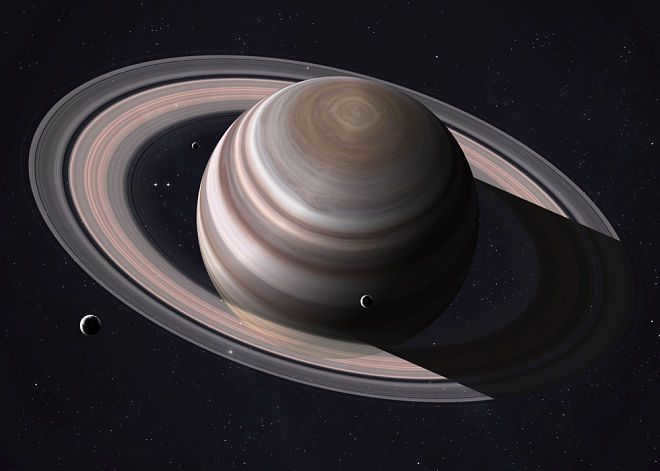

Neptune, with a radius of 24622 km, is the smallest gas giant in our Solar System. By contrast, Earth’s radius is a mere 6371 kilometers. On the other hand, Jupiter, with a radius of 69911 km, is the largest giant planet in our solar system, surpassing Earth’s radius by a staggering 318 times.
Unique Characteristics of the Atmosphere
When it comes to giant planets, their vast distance from Earth makes it challenging to ascertain the precise chemical makeup of their inner layers. Nevertheless, scientists have managed to gain a comprehensive understanding of the composition of their atmospheres. These atmospheres primarily consist of hydrogen, ranging from 80% in Neptune to 96% in Saturn. Following hydrogen, helium is the second most abundant element in their atmospheres.
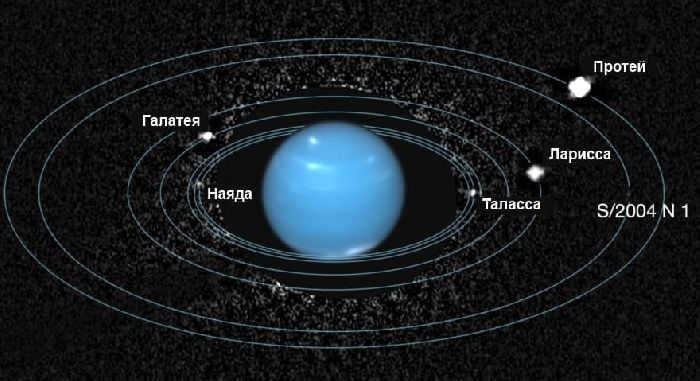
Gas planets contain various other elements in their atmospheres, but their combined concentration is no more than 2-3%. These elements include carbon, nitrogen, sulfur, and oxygen, which combine to form compounds such as hydrogen sulfide, methane, water, phosphine, and ammonia.
The group of giant planets in the Solar System is unique due to their shared characteristics. In addition to their massive size, these planets lack a solid surface, making their structure distinct. The dominant element found in these celestial giants is hydrogen, which exists in three different states: gaseous, liquid, and crystalline.
Allow me to take you on a brief journey into my area of fascination – astronomy! With knowledge of the number of planets within our solar system, it’s natural to wonder if they can be categorized into specific groups. But what are these groups and how are they classified?
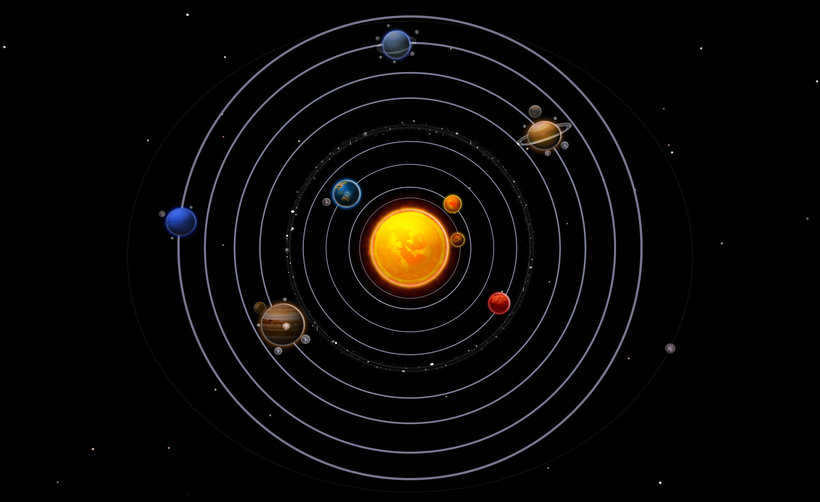
Categories of planets
Therefore, allow me to refresh your memory, there exist eight planets within our solar system, which are commonly recognized since our early schooling days – Mercury, Venus, Earth, Mars, Jupiter, Saturn, Uranus, Neptune. Furthermore, these planets have been classified into two distinct categories – terrestrial planets and gas giants. There are four planets in each category.
Gas giants
Out of the two categories mentioned earlier, our focus lies primarily on the second one, as per the question at hand. These planets are composed entirely of gases, a fact that is evident from their name. The gases that make up these planets are predominantly hydrogen, helium, methane, and ammonia. There are several distinct characteristics that allow us to group these planets together as gas giants:
- They possess an incredibly low density.
- The smallest of these planets has a mass that is 14 times greater than that of Earth.
- The duration of a day on these planets is relatively short, averaging only 10-15 hours.
- In terms of structure, these planets are quite similar to each other – they consist of a layer of gas in a gaseous state, followed by increasing pressure that causes the gas to transition into a liquid state, forming an analogue of Earth’s core.
Strong winds are always present on the surface of such planets, with their speed typically four times higher than the highest ever recorded on Earth.
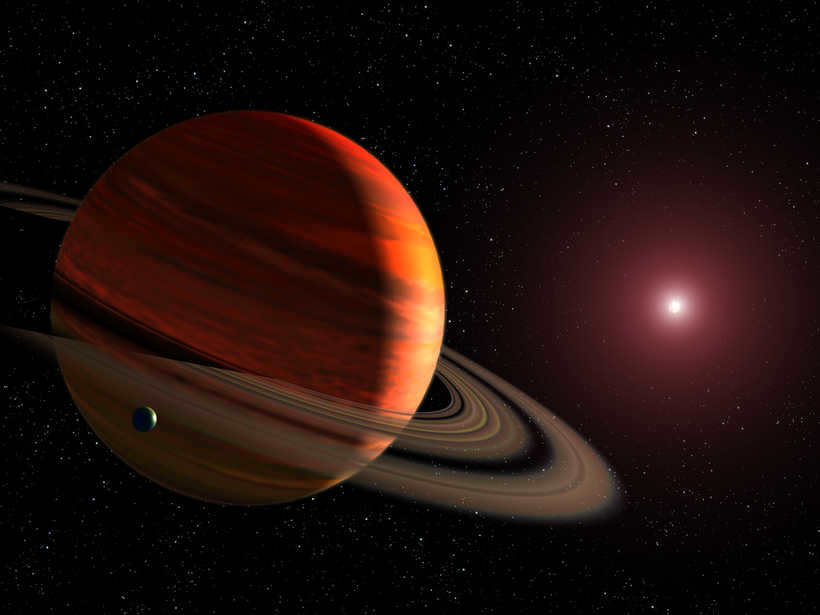
Gas Giants Group Composition
Identifying and memorizing the gas giants in the solar system is a simple task, as they are the final four planets: Neptune, Uranus, Saturn, and Jupiter. This arrangement is primarily supported by scientific evidence indicating that these planets formed much later than the initial four, resulting in their distinct composition.
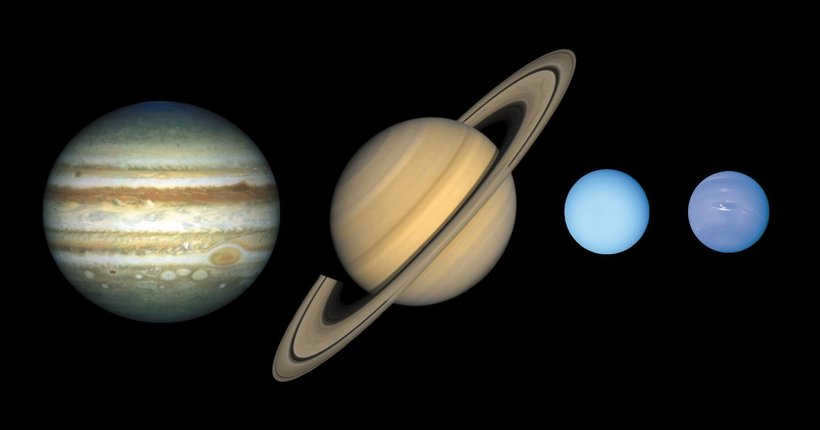
Although it is impossible for life to exist on gas giants, it is important not to underestimate the significance of this group. The gas giants’ favorable external location and immense size provide protection for the terrestrial planets against space objects.
I have previously mentioned that observing the night sky is one of my hobbies. I enjoy sitting outside on warm evenings and marveling at its beauty. Occasionally, I visit the planetarium and have even had the opportunity to visit a local observatory, where I observed the evening sky through a telescope. While I cannot be certain if I have seen planets, the sheer beauty of what I have witnessed is indescribable.
What planets are considered giant planets?
In the solar system, there are a total of eight planets. Each planet is distinct, intriguing, and enigmatic in its own right. The initial four planets, namely Mercury, Venus, Earth, and Mars, are classified as terrestrial planets. On the other hand, the subsequent four planets are renowned for their colossal size, earning them the title of giant planets:
These four planets are also known as the outer planets. I believe that is the correct designation. The giants are situated far from the Sun. What sets them apart from Earth’s planets is that they reside beyond the asteroid belt. They are called giants for a reason. They are two, maybe three times larger than Earth. However, they are much smaller in comparison to the Sun. And when it comes to mass, the giant planets cannot compare to the Sun.
- Jupiter and Saturn consist of solid hydrogen and helium, making them gas giants;
- Uranus and Neptune consist of low-temperature ice, earning them the title of ice giants.
Interesting facts about the enormous planets
The planets in our solar system are relatively unexplored. The enormous planets are located at such great distances from Earth that they can only be studied through theoretical means. However, there are some intriguing facts known about them:
- Each enormous planet possesses over 50 satellites. For instance, Jupiter has 60 satellites, whereas Earth only has one, which is the Moon.
- Similar to Earth, these planets orbit around the sun and rotate on their axes. However, their rotation speeds differ from that of Earth.
- Jupiter is the largest planet. It constitutes 70% of Earth’s mass. Jupiter spins at an incredibly rapid rate, with a day on Jupiter lasting merely 10 Earth hours.
We should express our gratitude to the giants for their invaluable contribution. Without their vigilant watch, life on Earth would be in constant peril. These celestial guardians shield us from the destructive forces of comets and asteroids, ensuring our safety and prosperity. Although our knowledge of the planets within our solar system is limited, we can only speculate about the vast mysteries that lie beyond. Perhaps future generations will unveil the enigmas of the unknown cosmos, for it is a realm teeming with countless secrets waiting to be discovered.
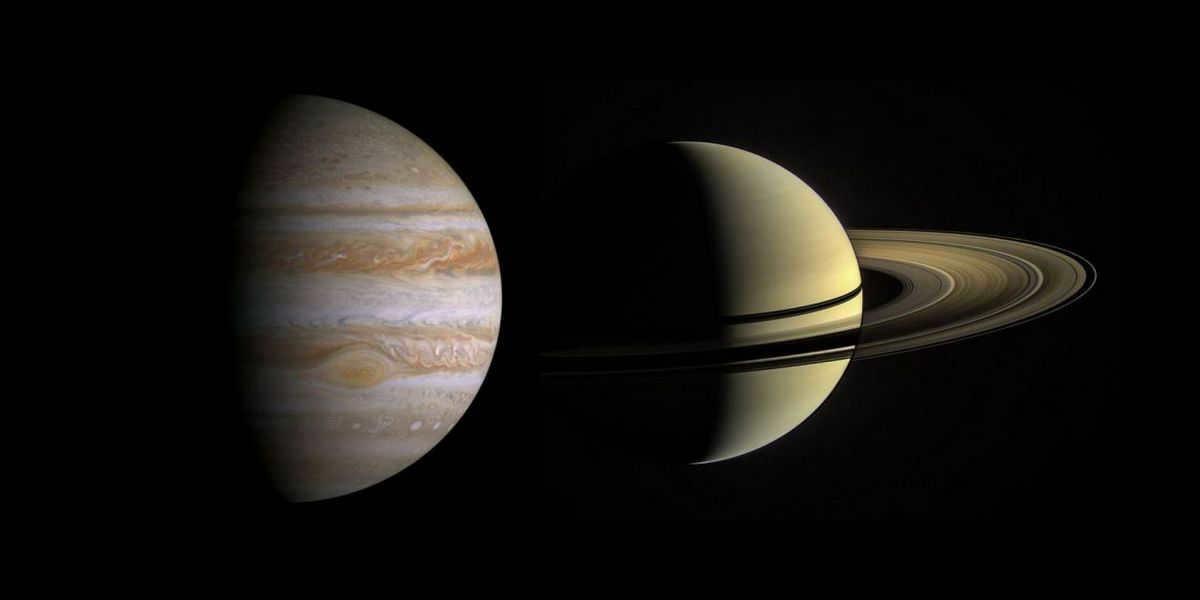
The celestial bodies that occupy our immediate vicinity in the solar system consist of various elements: Mercury, Venus, Earth, the Moon, Mars, and the asteroids are primarily comprised of iron and rock in different proportions. While some of these planets have oceans or atmospheres, the majority of their mass is solid.
However, this is not the case for the planets located further away from the Sun, namely Jupiter, Saturn, Uranus, and Neptune, which are predominantly composed of gases. These planets are also significantly larger than the rest, hence why they are referred to as “gas giants.”
The term “gas giants” was first used in 1952 by American science fiction writer James Blish in his short story “Solar Plexus,” where he described all the planets beyond Mars’ orbit as such.
Learning
During the creation of the solar system, the massive planets (which formed after the smaller rocky planets and initially consisted of solid rock and ice) managed to draw in and retain gases from the protoplanetary nebula thanks to their gravitational force.
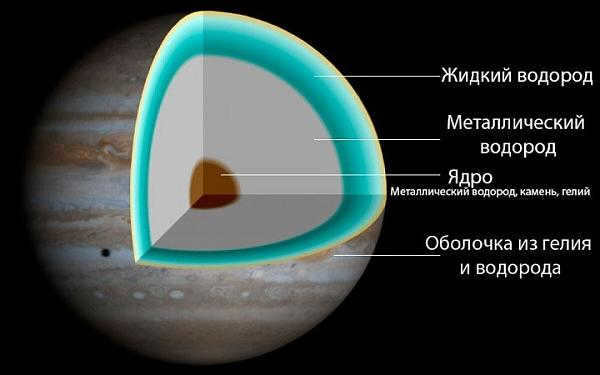
Due to their smaller masses, other planets were unable to attract gases. Approximately one million years after the formation of an accretion disk (which is a structure created from matter orbiting around a central body, such as a young star or protostar), a solar wind blew and expelled the remaining gas in the solar system beyond its boundaries.
Gas giants are unable to form past Neptune because the temperature drops to -100°C, making it impossible for substances like hydrogen and helium to exist in a gaseous state. Consequently, beyond this boundary, only icy bodies can be found.
Upon initial observation, the four gas giants display a striking resemblance: each possesses a diminutive rocky center encompassed by an icy layer and a hydrogen mantle. Nonetheless, meticulous measurements and calculations reveal that Jupiter and Saturn, the larger of the quartet, share a remarkable similarity in composition while exhibiting notable disparities from the comparatively smaller Uranus and Neptune.
Jupiter and Saturn represent the typical example
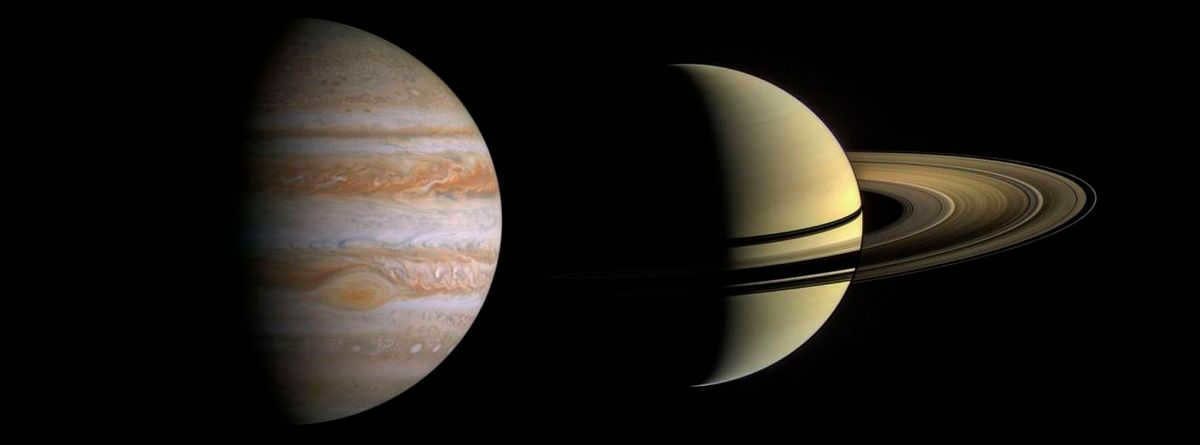
Jupiter is positioned fifth in terms of its distance from the Sun and is of such immense size that it occupies nearly half of the space separating the Earth and the Moon. Its mass is equivalent to 317 times that of the Earth. Jupiter completes its orbit around the Sun in 12 years and spins on its axis in under 10 hours, resulting in significant compression at its poles. The planet experiences hurricane-force winds that reach speeds of up to 600 kilometers per hour.
The immense masses of both Jupiter and Saturn generate tremendous pressure within these planets. This pressure causes hydrogen atoms to lose their electrons, resulting in an abundance of free electrons. As a result, hydrogen behaves as a conductor and exhibits properties similar to those of a liquid metal.
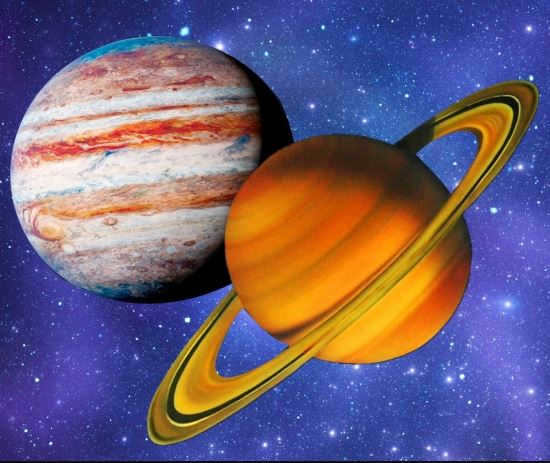
Saturn is situated in the solar system after Jupiter, possessing a massive size (equivalent to 95 Earth masses), and its density is lower than that of water. Saturn orbits the Sun every 29.5 years.
The winds on Saturn are even more powerful than those on Jupiter, blowing at an astonishing speed of 1800 kilometers per hour. One of Saturn’s moons, Titan, bears a striking resemblance to Earth.
This planet is surrounded by metallic hydrogen, which encloses a small solid core made of silicates and metal. It is this metallic hydrogen that generates the intense magnetic fields of both Jupiter and Saturn.
As you move away from the core, the pressure decreases, and the mantle consists of regular hydrogen.
Uranus and Neptune: The Icy Giants of Our Solar System
When it comes to the composition of our outer planets, Uranus and Neptune stand out from their gas giant counterparts, Jupiter and Saturn. Unlike their hydrogen-rich counterparts, Uranus and Neptune have a lower abundance of hydrogen, which is mostly concentrated in their outer layers. As a result, these two celestial bodies have a comparatively weaker magnetic field. The mantle of both Uranus and Neptune is composed of frozen water, methane, and ammonia, giving them their icy nature.
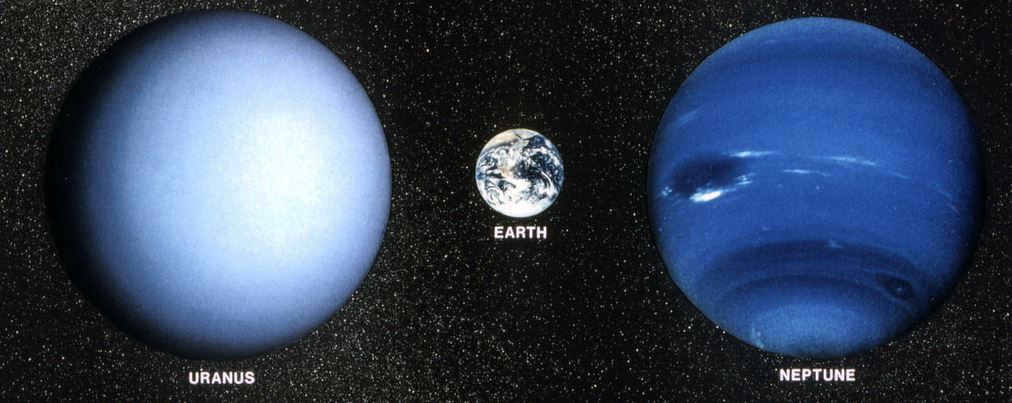
These three substances are referred to as “ice” by scientists, even though they remain in liquid form and are extremely hot due to the intense pressures and temperatures found in the planet’s substantial silicate and metal core.
Previously classified as gas giants, Uranus and Neptune are now classified as “ice giants”, leaving only Jupiter and Saturn as the recognized gas giants in our solar system.
Ambiance
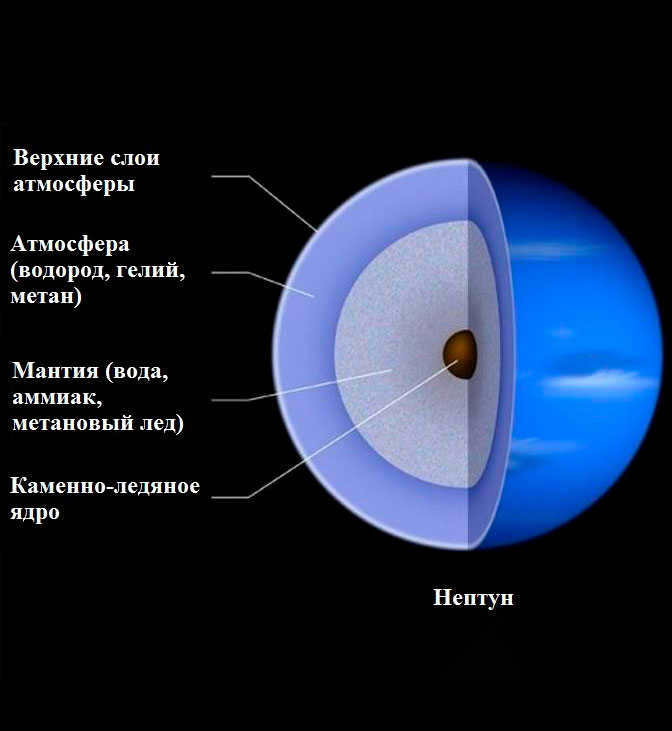
Gas giants possess a gaseous mantle layered above their atmospheres, similar to certain smaller planets. However, unlike terrestrial planets, there is no distinct boundary: under increasingly higher pressure, the gaseous state gradually transitions into a liquid state.
The demarcation between the mantle and the atmosphere can only be observed through temperature variations. Occasionally, the upper region of the atmosphere reveals itself through captivating cloud patterns when observed from Earth. The surface of a gas giant is considered the visible exterior of the planet’s atmosphere.
However, storms on the enormous planets can endure for centuries and are frequently confined to the same location. Jupiter, for instance, is perceived as a sequence of parallel cloud bands, consistently positioned at the same latitude.
Jupiter’s renowned Red Spot is a tempest that has persisted for at least 340 years and encompasses an area ten times larger than that of Earth.
The Hubble Space Telescope has been capable of detecting lightning on Jupiter that is a hundred times more potent than the lightning observed on Earth. Spectral analysis discloses the elements that compose the atmospheres of the enormous planets. On Jupiter and Saturn, it consists of a mixture of ammonia, ammonia-hydrosulfide, and water, while on Uranus and Neptune, it is predominantly methane.
Satellites and their rings
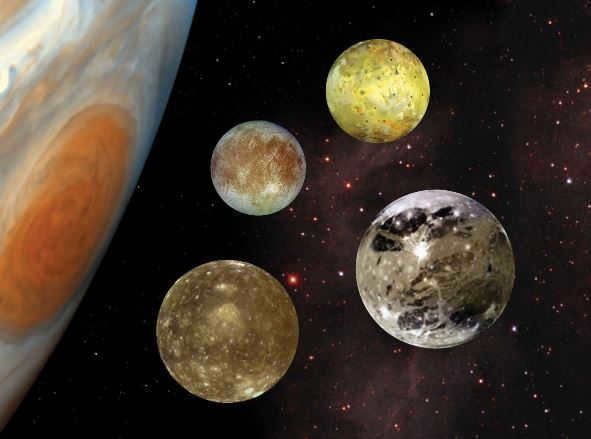
Gas giants are not alone in the universe: their massive size has enabled them to attract numerous moons (Jupiter has 63 satellites, Saturn has 62). Some of these moons are comparable in size to small planets, while others are only slightly larger than a rock.
Ever since Galileo Galilei first observed Saturn through his telescope, we have been aware of the planet’s vast ring system. Similarly, other gas planets are also encircled by delicate, wispy rings.
Exoplanets
Exoplanets are planets currently detected near other stars. These planets are usually gas giants, but this is not necessarily indicative of the overall prevalence of gas giants among planets. Rather, it is a result of the limitations of current observational technology, as gas giants are the most easily detectable using existing methods.
Nevertheless, there is a growing trend in the discovery of non-gas giant exoplanets around other stars.
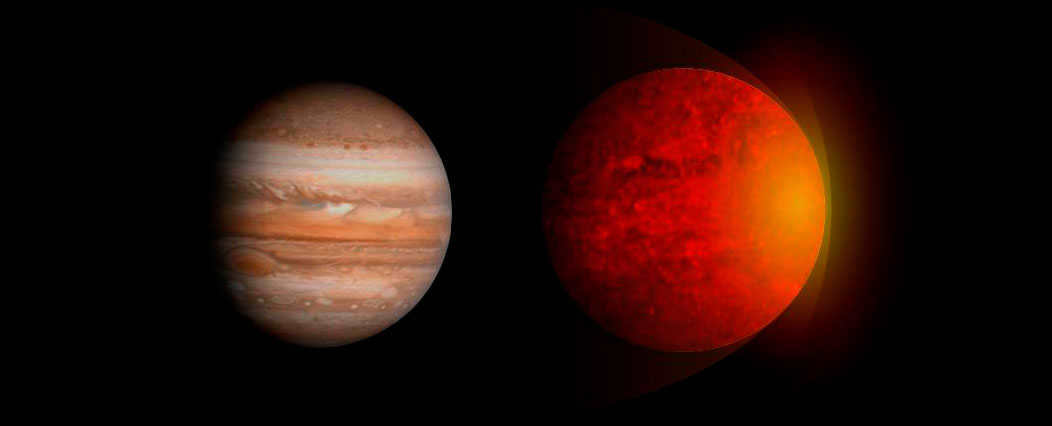
Among the gas giant exoplanets, one of the most remarkable is TrES-4, also known as TrES-4b. It was unveiled on August 7, 2007, as part of the Transatlantic Exoplanet Survey.
TrES-4 has a mass that is approximately 90% of Jupiter’s and a diameter that is nearly double. When it was first discovered, TrES-4 held the title for being the largest and least dense exoplanet on record.
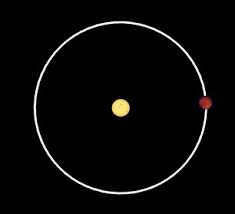
This particular planet is part of the star system GSC 02620-00648 in the constellation Hercules. The mass of the star is 20% higher than that of the Sun, and the planet is located approximately 1500 light years away from us. As it orbits around its sun every 3.55 days, there are moments when the planet appears brighter than the star, which is visible from Earth.
The cause of the exoplanet’s low density remains unknown, although one possibility could be the planet’s internal heat and its close proximity to its parent star (the distance from the star is 8 times smaller than the radius of Mercury’s orbit), resulting in surface temperatures that can reach up to 2000 degrees Celsius. Subsequently, it was discovered that the parent star is actually a binary star system, much older than our Sun, and is currently undergoing the transition into a red giant phase after depleting its hydrogen reserves.
Furthermore, it has been determined that in approximately one billion years, the exoplanet TrES-4 will be engulfed by its expanding sun.
So, in the past, all planets located beyond Mars’ orbit (which were only four in total) were classified as gas giant planets. However, a more precise categorization has been made, and now only Jupiter and Saturn are recognized as gas giants. The composition of these planets, consisting mainly of gases, makes it difficult to clearly determine the boundary between the planet itself and its atmosphere.
Outside of our solar system, new gas giants are constantly being discovered, and they share similar characteristics with the extensively studied Jupiter and Saturn.
Temperature variations conventionally draw the boundary without any clear demarcation.
The American science fiction writer James Blish mentioned this.
No, the gaseous state of hydrogen and helium is prevented due to low temperature.
Saturn’s orbit is situated between the orbits of Jupiter and Uranus. Which of these two planets is Saturn more similar in composition to?
Jupiter; both planets are gas giants, while Uranus (along with Neptune) are ice giants.
Hydrogen’s electrical conductivity is a result of high pressure causing electrons to depart from the nuclei of hydrogen atoms.
Get an Overview of Science Facts in Video Format
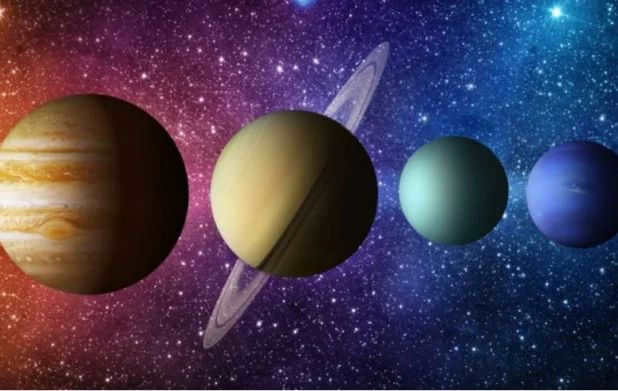
Just like how no two individuals are the same, there are no planets that are identical in the vast universe. They each vary from one another, primarily in terms of their size. In the field of astronomy, there is a classification known as giant planets. These include Uranus, Jupiter, Saturn, and Neptune.

In today’s fast-paced world, simply following the school curriculum is no longer sufficient. It is crucial to acquire valuable knowledge about finance and investments in order to secure financial stability.
Build a prosperous future for yourself by gaining an extensive understanding of financial literacy. Take advantage of the FINANCIAL LITERACY online course available today.


Join now, APPLY FOR YOUR SUCCESS
Jupiter is the biggest planet in our solar system
Astronomers regard Jupiter as the ruler of all planets in our solar system and place it at the top in terms of size. Because of its remarkable luminosity and majestic, unhurried motion among the stars, the planet was named after the supreme god of the ancient Romans. The planet can be seen in the sky for several months of the year. In terms of brightness, Jupiter is only surpassed by Venus in our solar system.
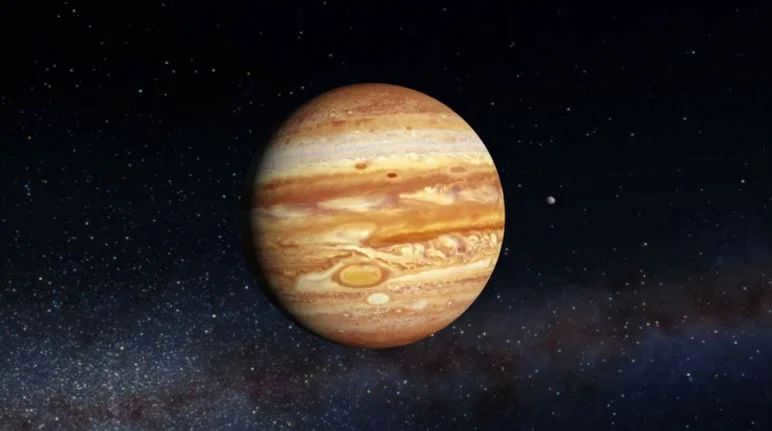
Jupiter is a massive planet that is 11 times larger in diameter than Earth, measuring 142,984 km. It also has a magnetic field that is 12 times stronger than Earth’s. However, despite its size, Jupiter is not composed of the same materials as Earth. In fact, if you were to compare the volume of Jupiter to Earth, you would find that it could fit approximately 1,300 Earth-sized balls within its volume. This difference in composition is why Jupiter is only 318 times the mass of Earth.
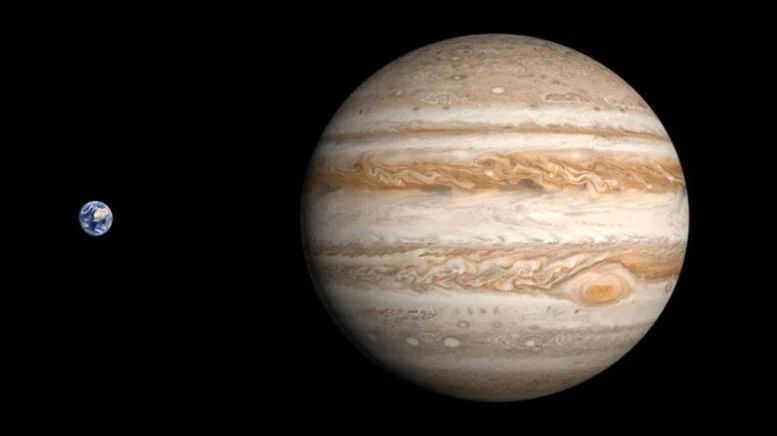
The giant planet’s mass is only slightly greater than that of water. It has an average density of 1330 kg/m3, which is surprisingly low for a celestial body of its size. Consequently, after conducting extensive research, scientists have determined that Jupiter, as the largest planet in our solar system, is composed predominantly of liquid and gas. The vast majority of its composition is hydrogen (87%) and helium (13%). Additionally, Jupiter’s gaseous atmosphere contains traces of ammonia and methane. The behavior of Jupiter is quite peculiar, as there seems to be an unconventional source of energy within its core. Consequently, this colossal planet emits a significantly higher amount of heat into space than it receives from the Sun.
Researchers have completed a comprehensive analysis of Jupiter as a celestial body within our solar system through an extensive investigation involving the Voyager-1, Voyager-2, and Pioneer spacecraft. They have deemed it to be an “atypical” planet. Firstly, this colossal entity possesses a peculiar elongated form. Additionally, it lacks a distinct density, resulting in a significant expansion around its equatorial region due to its rapid rotation. Presently, there exists a substantial disparity in diameter between the equator and the poles, measuring approximately 4400 km.
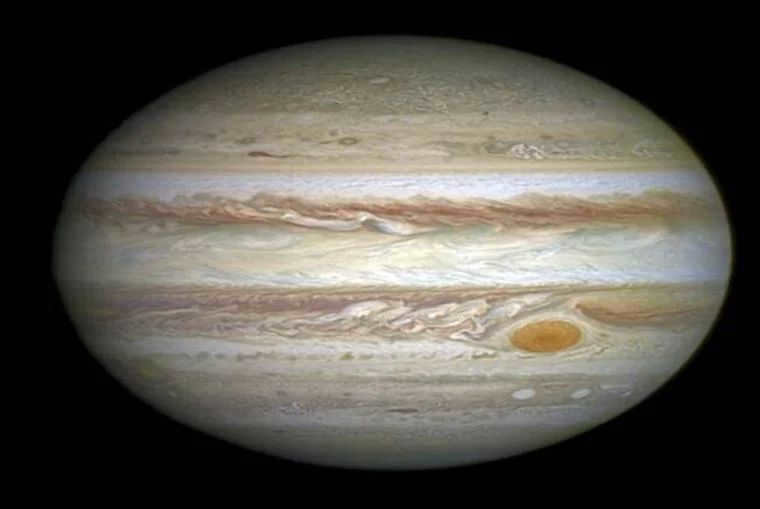
Furthermore, Jupiter exhibits a distinctive striped pattern with clearly visible bands of light and dark hues across its surface. Interestingly, the location of these stripes undergoes annual changes, indicating that they are not geological features such as mountains or oceans, but rather long bands of clouds in different colors. These clouds race across Jupiter’s atmosphere at astonishing speeds of up to 100 meters per second. When these “atmospheric expresses” collide, they give rise to powerful tornadoes. The movement of these clouds has allowed scientists to determine the rotational speed of Jupiter, which is quite remarkable: a day on this planet lasts only 9 hours and 50 minutes, making it the fastest rotating planet in the entire Solar System.
300 years ago, scientists made the initial discovery of a mysterious swirling formation within the clouds of Jupiter – a massive Red Spot. The peculiar shape and immense size led scientists to speculate that it may be a live volcano or even an iceberg, floating within the planet’s atmosphere.
The colossal planet completes its orbit around the Sun in a span of 12 years. Jupiter resides at a significant distance from the Sun, resulting in extremely frigid temperatures within its atmosphere. In the upper layers, the temperature plummets to minus 140 degrees Celsius. However, delving deeper into the planet, the intense pressure causes the gases to transform into liquid form and subsequently boil. In the event of a meteorite impact on Jupiter, numerous kilometer-long waves of matter are expelled upwards.
In 1994, astronomers witnessed a tumultuous tempest in the atmosphere of the planet. This event occurred as a consequence of a significant disaster. The planet Jupiter experienced the impact of the Shoemaker-Levy comet, which ignited a spectacular pyrotechnic spectacle. The comet fragmented into numerous pieces, which subsequently plunged into a seething expanse of gaseous fluid.
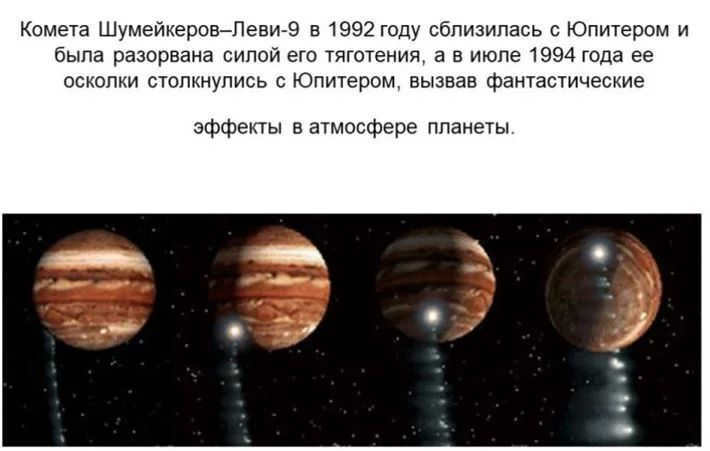

Key Features of Saturn
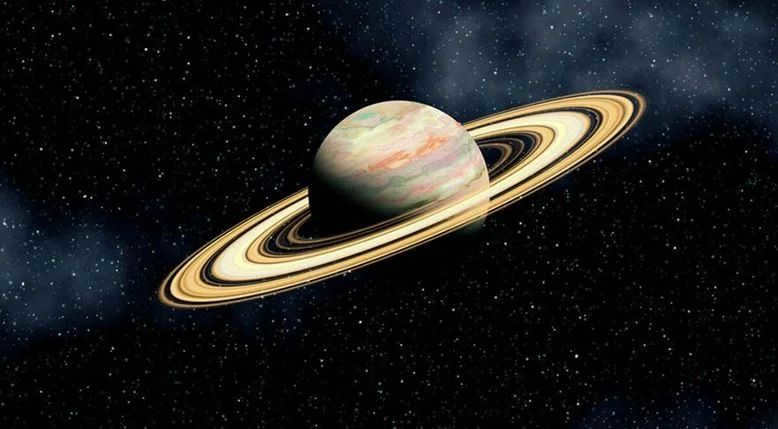
The atmosphere of Saturn is similar to that of Jupiter, consisting mainly of methane and ammonia. In the upper layers, ammonia solidifies, creating crystals that make the atmosphere opaque. Saturn itself is primarily composed of hydrogen and helium, with the interior transitioning into a liquid state. In regions where gravity weakens and pressure decreases, a gaseous zone forms.
Saturn is located 1,431 million kilometers away from the Sun, which is nearly 10 times the distance of Earth’s orbit. As a result, the Sun’s rays have difficulty reaching the surface and warming it. In fact, Saturn is only warmed 90 times less than Earth. To put it in perspective, Jupiter is 3.5 times warmer. Due to this distance, the surface temperature of Saturn can reach as low as minus 150 degrees Celsius.
The central region of a massive planet differs from that of Jupiter. Instead of being composed of compressed gases, it consists of solid rock. This peculiar “nucleus” of Saturn is enveloped by a surrounding layer of metallic hydrogen infused with traces of helium.
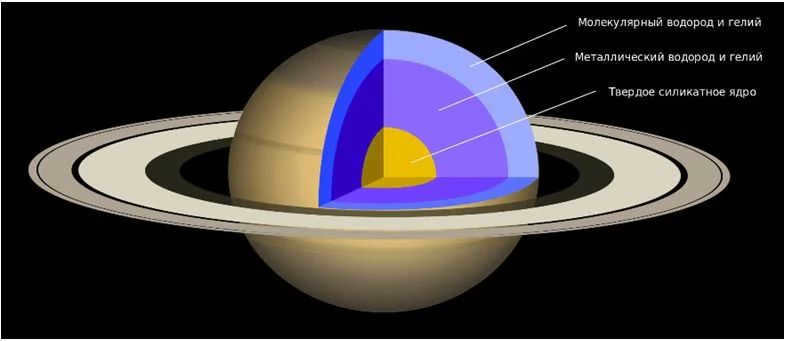
Saturn’s internal structure
Uranus is an ice giant
In the 18th century, scientists believed that Saturn was the furthest planet in the solar system. However, they suspected that there could be other celestial bodies beyond its orbit. This suspicion was confirmed in 1781 when the renowned English astronomer W. Herschel observed a luminous object in his telescope that was not present on any star map. After observing it for several days, he determined that it was a planet and named it Uranus.
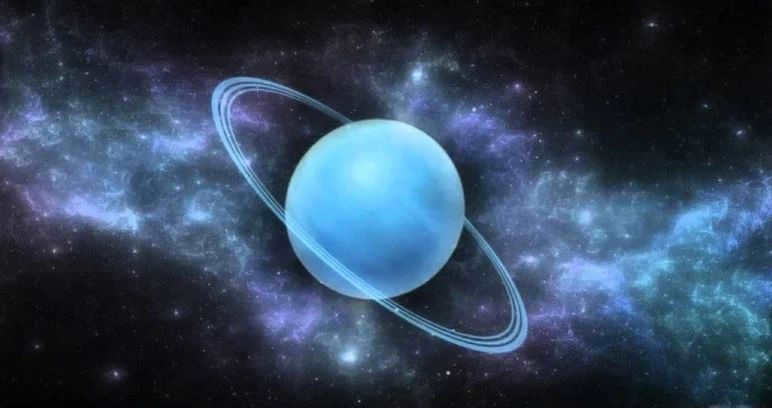
Source
Over time, it has been discovered that Uranus is located at a distance of 2877 million kilometers from the Sun. This means that the giant planet is 19 times farther away from the Sun compared to Earth. Even Saturn, which is the closest planet to Uranus, is only half as close to the Sun. Uranus takes approximately 84 years to complete one orbit around the Sun.
- The atmosphere is composed of gases.
- It forms a gas envelope around a planet.
- The ocean on a planet is made up of water, ammonia, and methane.
- At the center of a planet, there is a core.
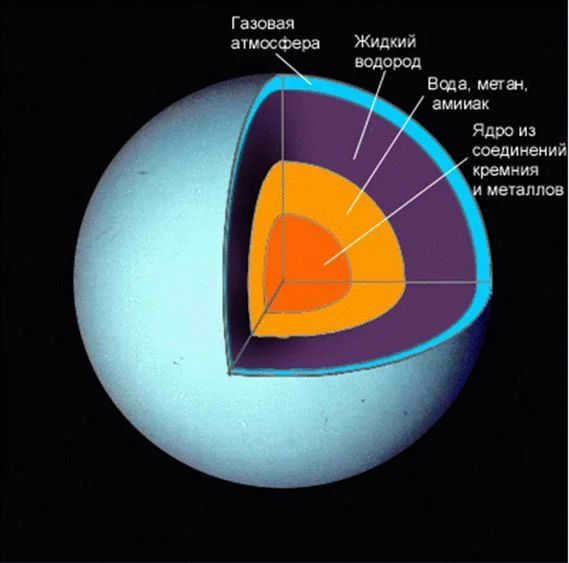
Source
The abundance of methane in the clouds gives this gas giant a stunning blue-green hue. With no solid surface, Uranus experiences periodic gusts of wind in its atmosphere as a result of temperature fluctuations. These winds help regulate the temperature of the upper layers, creating a constant cold of minus 200 degrees Celsius on the planet’s surface.
The majority of the matter on the planet is composed of hydrogen and helium. However, unlike Jupiter or Saturn, Uranus does not have metallic hydrogen in its core. This unique substance can only be formed under conditions of extremely high pressure. The absence of metallic hydrogen in Uranus is due to its smaller size compared to the other gas giants. The gas envelope makes up approximately one third of the planet’s radius, which is around 8,000 kilometers. Below the gas envelope lies the actual ocean, which has a depth of about 10,000 kilometers. This dense mass is made up of a combination of methane, ammonia, and water. The surface of the ocean is heated to a temperature of +2000 degrees Celsius, thanks to the intense pressure from the lower atmosphere. At the core of Uranus, there is a solid rock and metal core that is heated to a staggering +7000 degrees Celsius.
Uranus experiences noticeable compression at its poles. Similar to Saturn and Jupiter, it is surrounded by a hazy atmosphere. Methane dominates its composition, with a nearly complete absence of ammonia. This is due to the extreme coldness at such a great distance from the Sun, causing the ammonia to freeze and appear as white “snow”.
Uranus didn’t come as the final surprise for astronomers. Scientists who were studying the path of this planet noticed some peculiarities. The “wrong” movement of Uranus could only be explained by the gravitational pull of an even more distant planet. It was this planet that was causing Uranus to deviate from its orbit. The existence of this new celestial body was initially discovered through mathematical calculations. French astronomer W. Leverrier and English scientist J. Adams independently carried out a series of calculations and in 1864, they both pointed to the exact spot in the sky where the new planet, Neptune, was “hidden”.
Discovered in this location by a young astronomer named Gottfield Halle from the Berlin Observatory, this planet earned its name due to its remarkable hue. It is widely known as the blue planet, but in reality, it possesses a stunning shade reminiscent of sea waves, which is a result of the presence of methane gas in Neptune’s atmosphere.
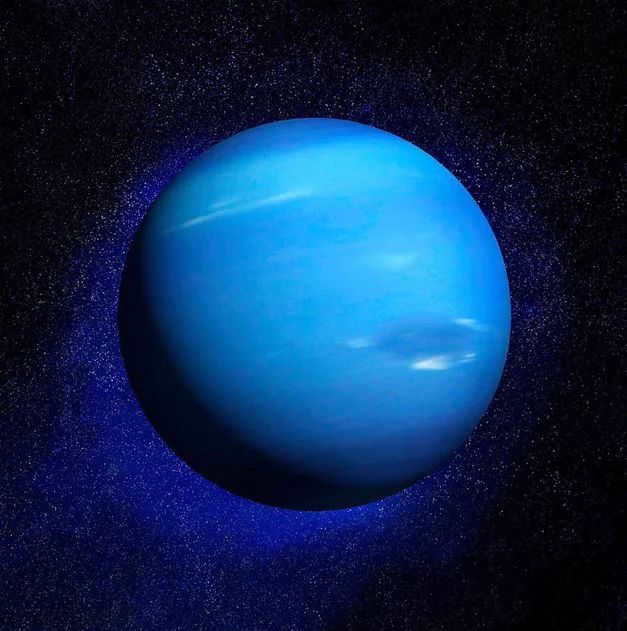
Neptune is relatively small compared to other planets of its type. Its size is only four times that of Earth, with a diameter at the equator of 49528 kilometers. However, despite its small size, Neptune is incredibly heavy, weighing as much as 17 planets like our own.
This eighth planet is located 30 times further from the Sun than Earth, resulting in a year length of 164 Earth years for Neptune to complete one orbit around the Sun. However, despite its slow orbit, Neptune spins on its axis just as quickly as other gas giants, with a day on the planet lasting only 16 hours.
Neptune is composed of multiple layers:
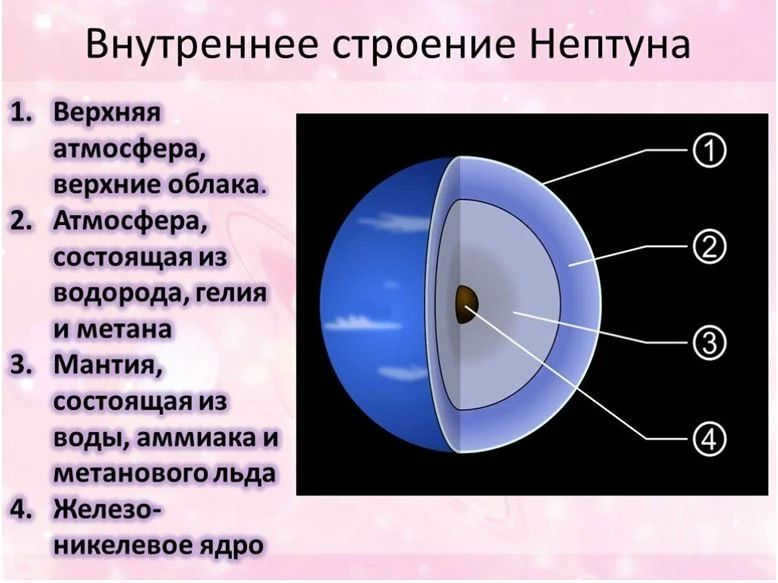
Source
Uranus has a thicker atmosphere compared to Neptune. The majority of its composition is made up of hydrogen and helium. Just below the atmosphere lies a more compact layer. However, instead of having liquid gases like the planets closer to the Sun, Uranus has a crumbly combination of frozen methane, ammonia, and water. Researchers have discovered a relatively large rocky core beneath this mass. Similar to other massive planets, Neptune’s atmosphere displays remarkable gigantic vortex formations that can last for a considerable amount of time. The enigmatic Great Dark Spot serves as an illustration of this extraordinary phenomenon.
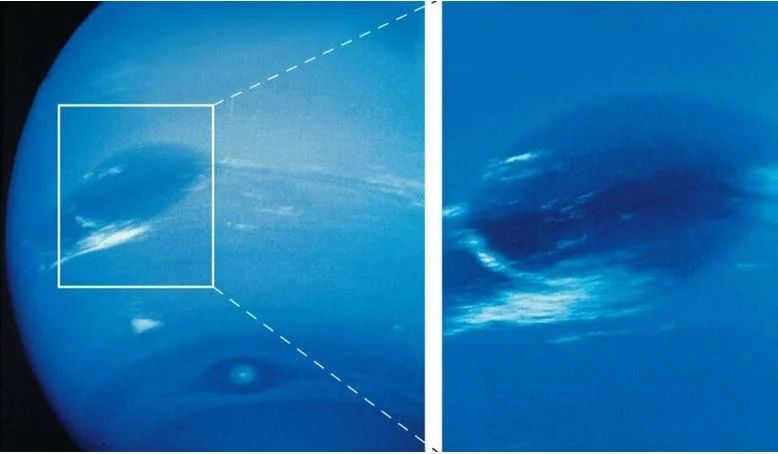
The moons of the giant planets
Each of the giant planets has its own moons, which, similar to the planets themselves, vary from one another.
Jupiter’s moons
The largest planet, Jupiter, has 79 moons. When observing through a telescope, you can clearly see four brightly shining stars near its disk. These are the largest of Jupiter’s moons, which were initially discovered by Galileo. Each moon has its own individual name:
- Io is a moon of Jupiter that is in very close proximity to the planet. In order to avoid crashing onto the surface of its massive host, it is compelled to orbit at an incredibly high speed. The moon manages to complete a full orbit around Jupiter in 42.5 hours;
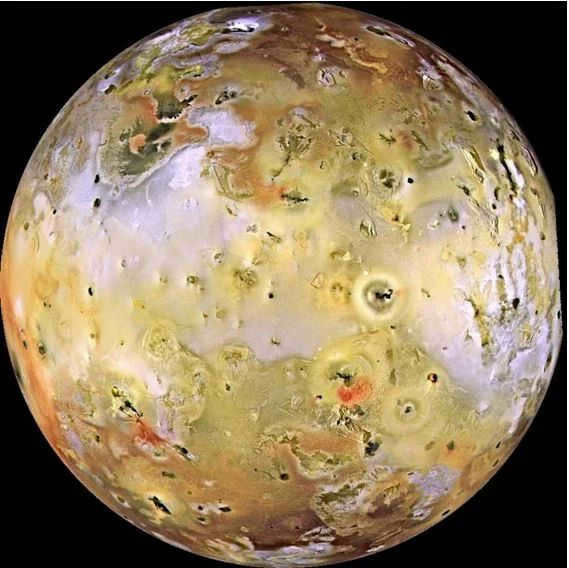
- Io is larger than Europa in size. This moon is entirely enveloped in a frozen water shell, providing it with a vibrant and radiant appearance. Scientists hypothesize that beneath the icy exterior lies a genuine ocean, potentially harboring life. Researchers are currently experimenting with various methods to penetrate Europa’s icy surface. As a suitable training “testing ground,” scientists have chosen the renowned relic lake Vostok in Antarctica. However, the ice layer there is relatively thinner, measuring only about 4 kilometers;
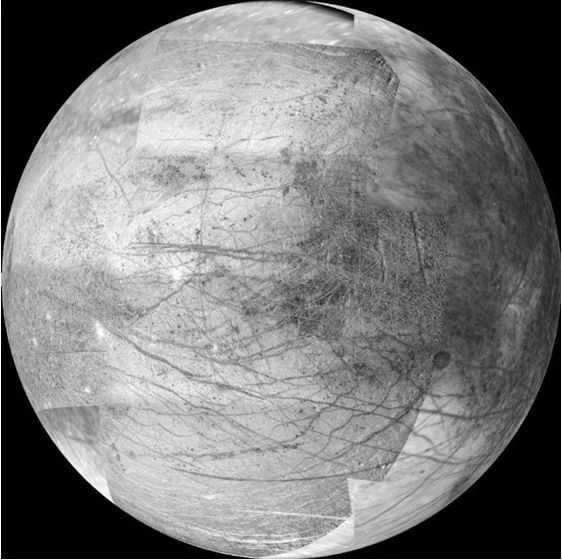
- Ganymede is an actual giant. It measures 5,260 kilometers in diameter. Not only is it the biggest moon of Jupiter, but it’s also the largest moon in the entire solar system. If this celestial object orbited the Sun instead of a giant planet, it would have a great chance of becoming a fully-fledged planet;
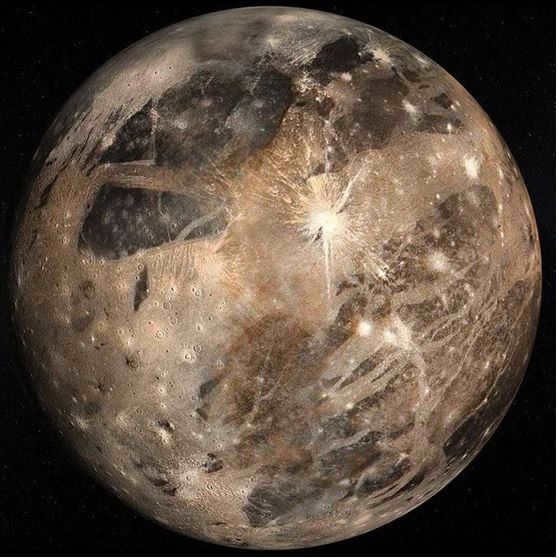
- Callisto, one of the giant planets in our solar system, is situated in a distant orbit around Jupiter. Its orbital path takes approximately 16.7 days to complete, similar to the phases of our Moon. Notably, Callisto bears a prominent scar on its surface, resulting from a collision with an unknown cosmic object in the past. Despite the impact, Callisto managed to withstand the force and remained intact, albeit a massive crater measuring 350 kilometers in diameter was formed as a result. Additionally, the collision gave rise to the formation of ring mountains on the satellite.
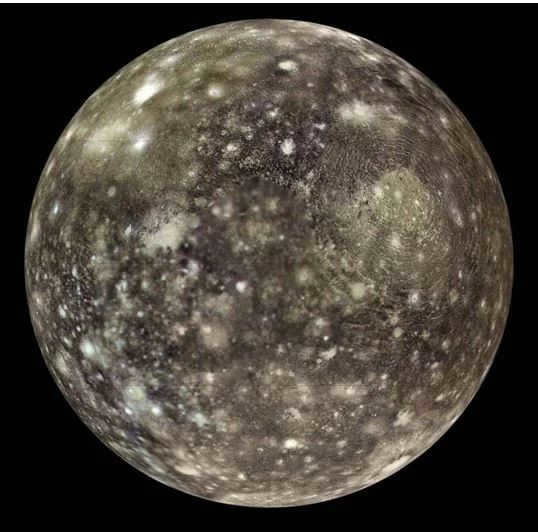
The satellites are incredibly bright, to the extent that if it were not for the sheer brilliance of Jupiter, it would be feasible to observe these entities without any aid.
The Satellites of Saturn
At a significant distance from Saturn, 82 satellites were created from “debris” in space. Astronomers are continuously uncovering new entities that “accompany” the planet. As a result, the number of satellites revolving around the colossal planet is in constant flux. Eight objects have quite substantial dimensions:
Titan is Saturn’s largest moon, with a diameter of 5150 kilometers, making it much bigger than Mercury. It is the second largest moon in our solar system and the only one known to have an atmosphere. The atmosphere of Titan is rich in methane and nitrogen, which gives it a bright yellow color.
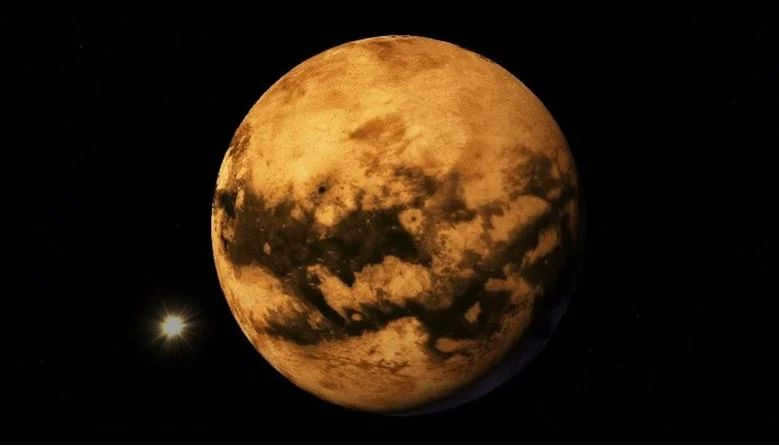
Japet is one of the most unique moons in our solar system. With a diameter of 1,440 kilometers, it has a peculiar feature where one hemisphere is 10 times brighter than the other. Researchers propose that this unusual celestial body came into existence as a result of a collision between two other sizable objects with distinct compositions.
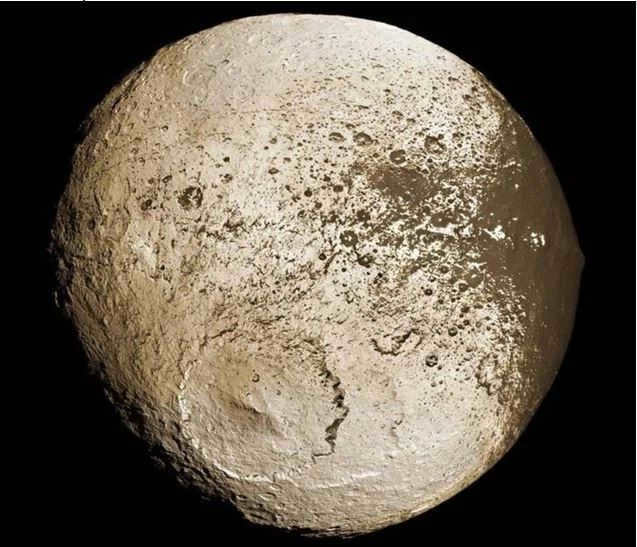
Theba is an enigmatic moon of Saturn that stands out due to its distinctively dark hue, resembling a formless mass of darkness. With a diameter of just 220 kilometers, Theba orbits around the massive planet in a period of 1.5 years. What sets Theba apart from its fellow moons is its unique retrograde motion, moving in the opposite direction – clockwise.
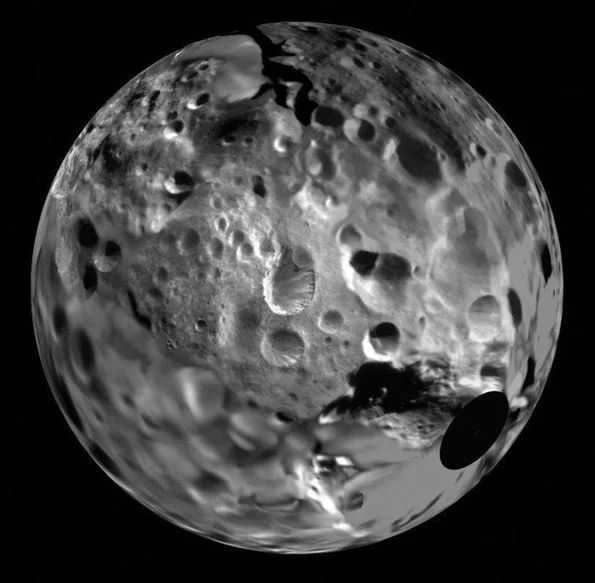
There are numerous distinctive and extraordinary satellites among Saturn’s smaller ones. Take Janus and Epimetheus, for instance. They exist in virtually identical orbits, regularly swapping positions. It baffles scientists how they haven’t collided and disintegrated into particles.
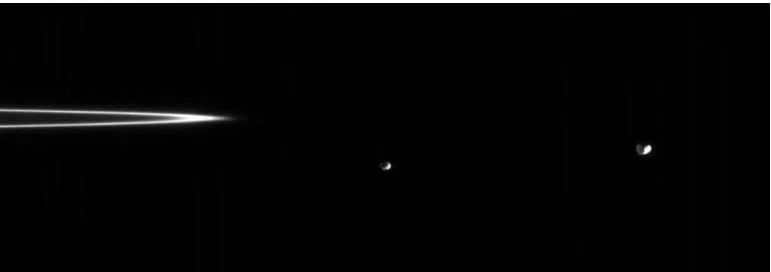
On either side of the planet’s ring, Prometheus and Pandora exhibit perfect symmetry. The gravitational force exerted by these moons causes the particles within the ring to intermingle, creating a distinctive braided pattern.
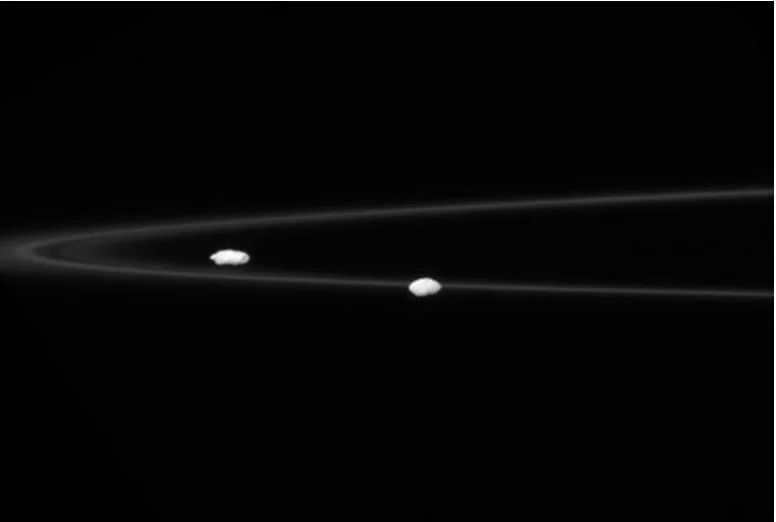
The Moons of Uranus
As of 2013, a total of 27 moons have been discovered around Uranus. Initially, these moons were not given official names. Following a tradition dating back to the 17th century, the moons were eventually named after characters from mythology associated with the deity after which the planet was named. In the case of Uranus, the names were inspired by the works of William Shakespeare and Alexander Pope. Some of the moons of Uranus include:
- Rosalind;
- Cupid;
- Belinda;
- Puck;
- Mab;
- Miranda;
- Oberon;
- Titania.
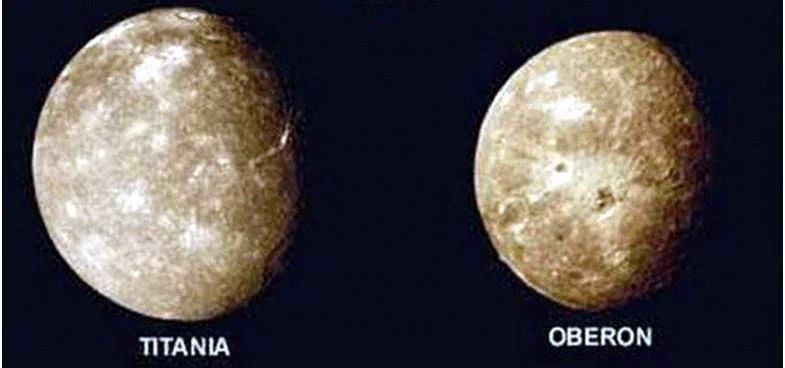
Miranda has reached the most astonishing celestial bodies that encircle Uranus. Having a width of 400 kilometers, the peaks on it have escalated to a height of 5 kilometers. And adjoining the extraordinary stones are crevices of the identical profundity. However, the most intriguing spot that scientists have discovered is in the vicinity of the southern pole. Evidently, there is an extraordinary cavity with a profundity of 15 km. All the principal satellites, apart from Miranda, are composed of ice and rocks. Miranda is solely composed of ice. It is believed that the ice is comprised of ammonia and carbon dioxide.
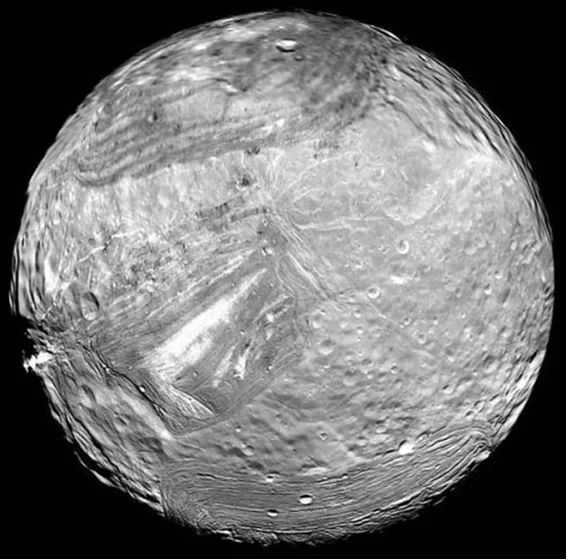
The Moons of Neptune
Neptune possesses a smaller number of moons compared to other gas giants. Numerous moons were only identified by astronomers during the 20th century, despite the fact that the planet itself had been recognized since 1846. Some of these moons include:
- Triton;
- Galatea;
- Naiad;
- Thalassa;
- Nereida;
- Proteus and others.
Triton, the largest of these satellites, stands out because of its unique rotation. Unlike other satellites, Triton rotates in a clockwise direction rather than counterclockwise. These “wrong” satellites are rare in the solar system and tend to be relatively small in size. However, Triton is an exception to this, with a diameter of 2700 kilometers. The surface of Triton is covered in frozen gases, and its poles have frozen nitrogen “caps.” At times, the sun’s rays can melt some of the ice on this frozen world, causing the nitrogen to turn into a liquid state. This results in spectacular 10-kilometer nitrogen fountains on the satellite’s surface. Scientists believe that Triton initially formed as a small planet but was unable to establish its own orbit around the Sun due to the strong gravitational pull of its massive neighboring celestial body.
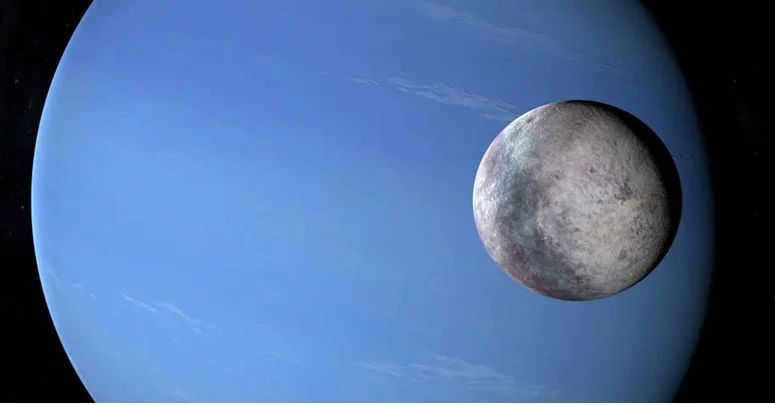
Source
There is another remarkable satellite called Nereid that stands out for its unique orbit. Unlike other satellites, Nereid has an extremely elongated path, setting a record in the solar system. It is plausible to assume that Nereid initially followed a more typical trajectory but some catastrophic event caused its path to become “stretched”.
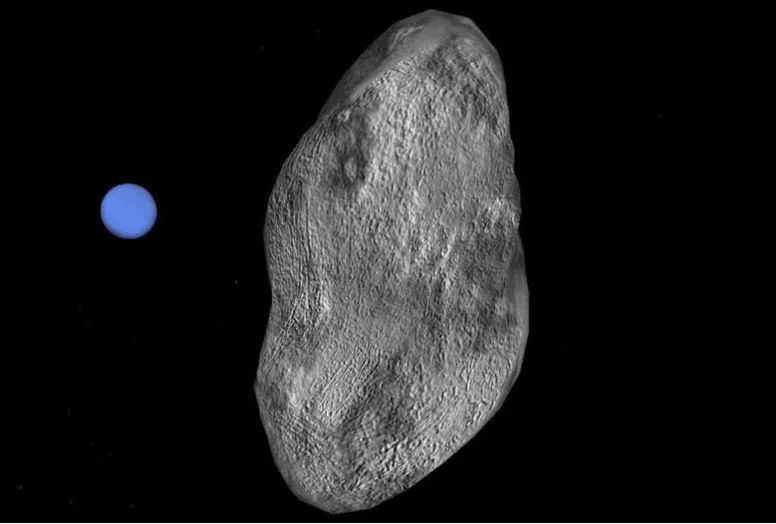
Source
Volcanic activity on Io, a moon of Jupiter
Io’s surface is intensely heated, as it is the home to 12 active volcanoes. These volcanoes can reach heights of up to 9 kilometers and temperatures in these areas can rise to +300 degrees Celsius. It is a world of seething lava. The volcanic plumes on Io can extend up to 300 kilometers into space. From a distance, Io glows with various shades of yellow.
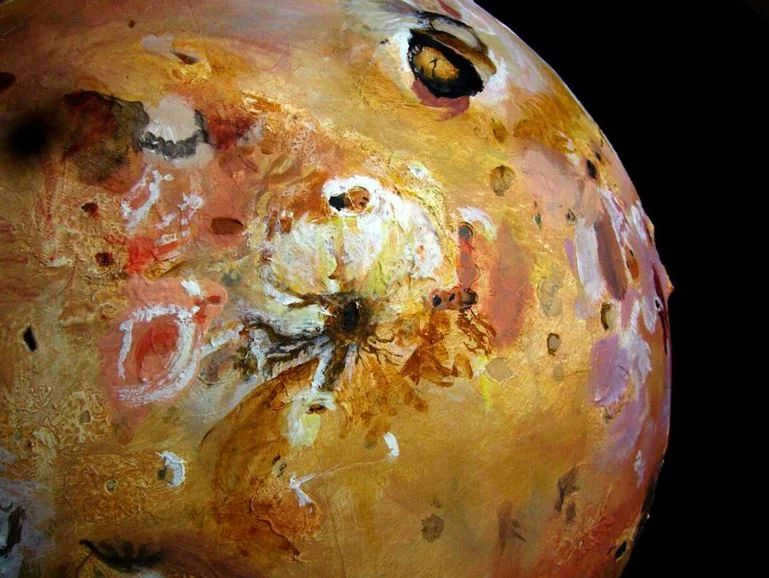
An erupting volcano on Io Source
The origin of the rings surrounding the massive planets
All four massive planets in our solar system possess rings, each with its own unique characteristics. When the Pioneer spacecraft flew near Jupiter in 1974, no rings were observed in its images. However, in 1979, the Voyager spacecraft revealed the existence of rings around this planet. Interestingly, this discovery was not made from Earth, but rather with the assistance of the Voyager spacecraft. Scientists have determined that the rings surrounding the massive planets are composed of a combination of rocks and dust. There are two prevailing theories regarding their formation: one suggests that they were created through the collision of satellites, while the other proposes that the rings formed as a result of Jupiter’s gravitational force attracting space objects.
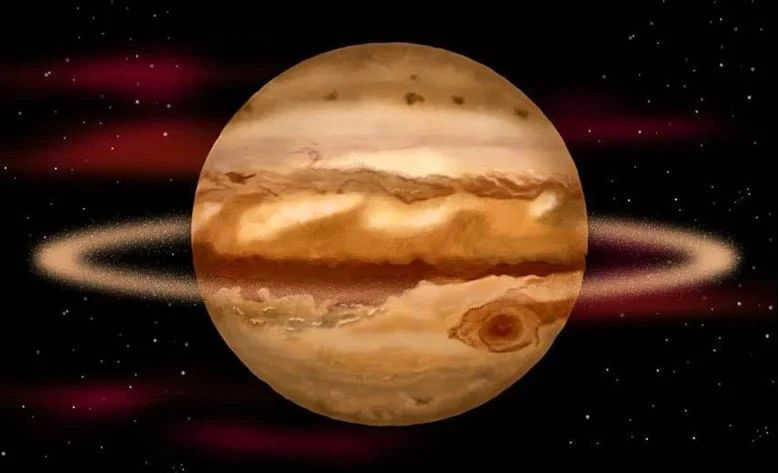
Source
Saturn is the only cosmic object that boasts such a spectacular “ornament” – rings that encircle the giant planet. What distinguishes these rings from those around other giant planets?
Saturn possesses the largest ring compared to the rings surrounding the other massive planets. This ring is completely flat, remarkably broad, and bears a resemblance to the brim of an enormous hat. Upon observing this planet for an extended period, one can observe the ever-changing nature of this “hat”. It rotates, presenting different sides to us, and once every 15 years, it fully vanishes from sight. These transformations in the ring occur due to its inclination, being tilted at a 26-degree angle in relation to the Earth. Saturn completes its orbit around the Sun within a span of 29 years. Depending on its position in its orbit, we can witness the unfolding of its ring. When it aligns edge-on with us, it becomes indistinguishable even with the aid of a powerful telescope. Scientists have deduced that the ring must be relatively thin, with modern calculations estimating its thickness at a mere 20 kilometers. This measurement is minuscule in the grand scheme of cosmic proportions.
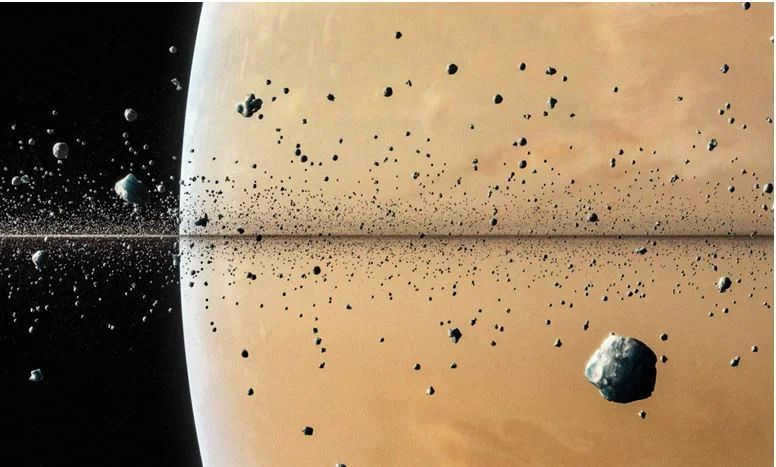
Saturn’s ring up close Source
The presence of rings around the colossal planet was uncovered by the renowned astronomer Galileo Galilei and Dutch scientist H. Huysen. In 1655, Huysen determined that the structure encircling Saturn is a flat ring, which does not make contact with the planet’s surface. Saturn is encompassed by a total of three ring formations. They are denoted as A, B, and C and appear to be nested within one another. The first two are separated by a noticeable gap known as the Cassini gap. The outer ring (A) possesses a moderate level of luminosity. In 1837, a small division was observed in the A ring, referred to as the Enke division. The B ring emits a significantly brighter shine. Conversely, the inner ring (C) is translucent and exudes a slight shimmer.
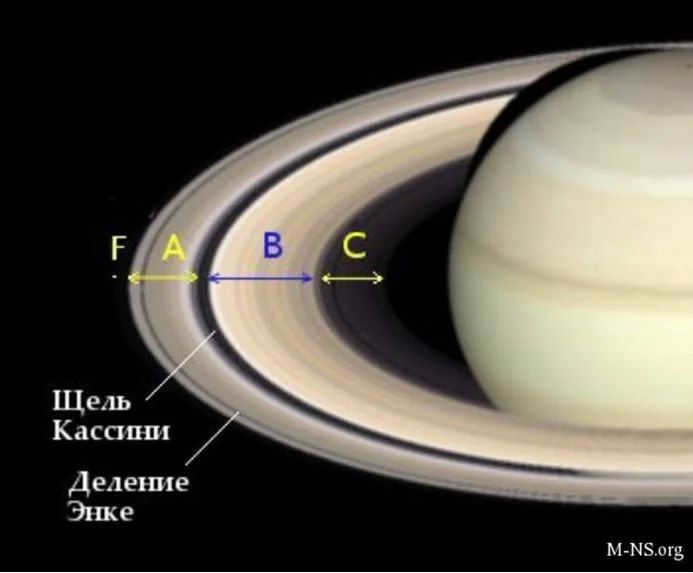
Source
Scientists have already discovered the origin of Saturn’s rings. Previously, it was believed that the planet’s rings were formed from a large number of satellites that were gradually broken apart by the planet’s gravity. However, recent space missions have revealed that this is not the case. It has been found that the rings of Saturn are actually made up of protoplanetary matter, remnants of the cloud from which the planet formed. Over billions of years, these fragments of matter have broken apart and mixed with gases and dust, creating the beautiful rings that we see today.
The rings can only be seen as dense when viewed from a significant distance. Unique photographs taken between 1979 and 1981 by the Pioneer 11 and Voyager spacecraft revealed that the rings consist of numerous narrow “hoops”.
Uranus, like other gas giants, also possesses a ring system. Interestingly, these rings were actually discovered before Jupiter’s rings, which had been known for a considerable time. As of 2008, astronomers have identified 13 such formations. All of them are relatively thin, with a maximum thickness of 10 meters. Their widths range from 1 to 10 kilometers. The only exception is the outer ring, which expands to 96 kilometers at its farthest point from the planet. The rings are composed primarily of dark rocky material.
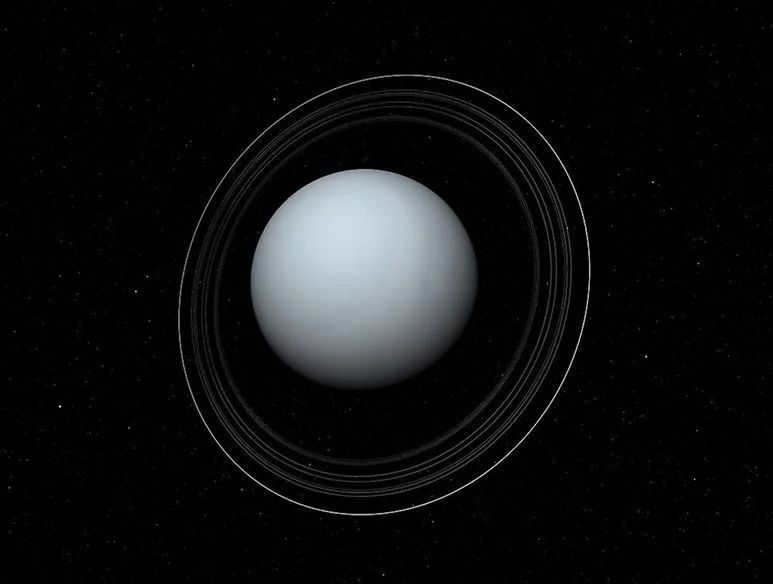
Source
Neptune also possesses a set of rings. In 1846, there was initial speculation regarding their existence, and it wasn’t until 1989 that contemporary astronomers were able to precisely determine their quantity – 6. Comprised of ice and an unknown dark material, these rings exhibit a dusky appearance. It is postulated that this material originates from organic sources, as suggested by its reddish tinge.
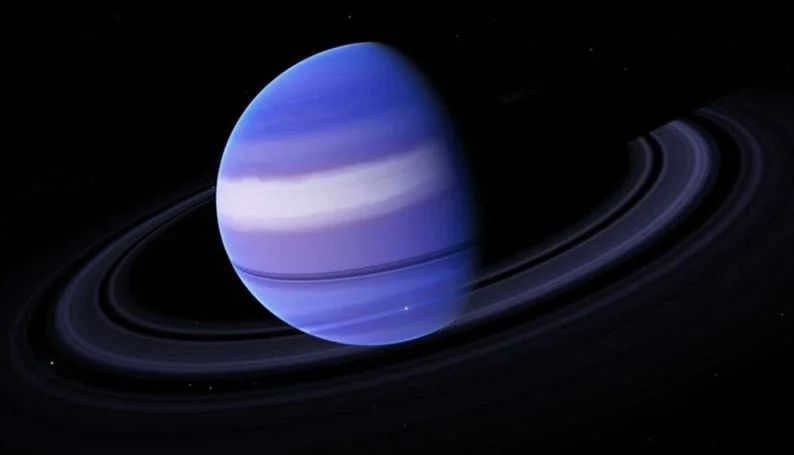
Source
Back in 2016, scientists put forward a theory about the potential existence of an additional colossal planet. It is believed that this planet’s diameter could be 2-4 times larger than that of Earth, and it would take a staggering 15,000 Earth years to complete a single orbit around the Sun. This hypothetical planet is thought to be situated well beyond the Kuiper belt, on the outer fringes of our solar system. Despite ongoing efforts, scientists have yet to locate this elusive planet, and at present, it remains purely theoretical.
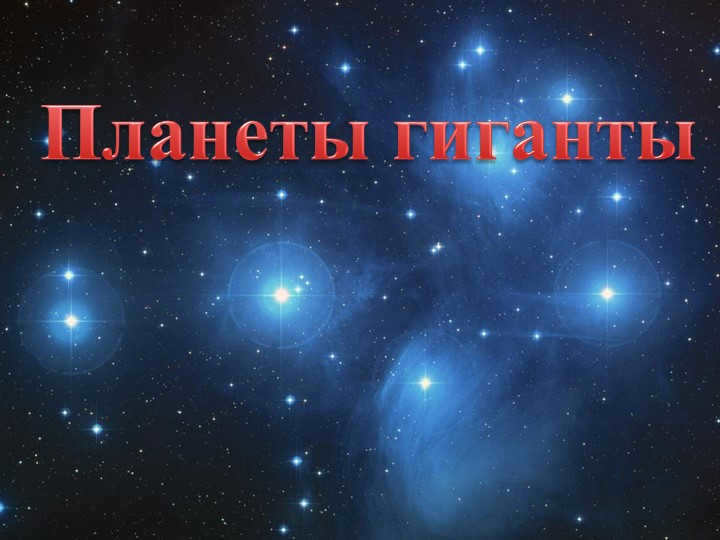
Currently, 58,741 educational institutions have access to additional cumulative discounts ranging from 2% to 25%. To determine the applicable discount for all staff members of your educational institution, please sign in to your personal Infoworks account.


Advanced training program
Adolescent melancholic conditions
We can incorporate the discount offered by your educational establishment into this promotion (the extent of the discount is contingent on the number of your peers who have taken Infoworks courses).
At present, there are 58,741 educational institutions that are eligible for supplementary cumulative discounts (ranging from 2% to 25%). To ascertain the applicable discount for all staff members of your educational institution, kindly log in to your personal Infoworks account.


Advanced training program
Compliance with safety standards for lifting equipment (B.9)
In addition to this special offer, we can also apply a discount specific to your academic institution (the amount will depend on the number of your colleagues who have completed Infoworks courses)
Currently, there are 58,741 academic institutions eligible for additional discounts (ranging from 2% to 25%). To determine the discount applicable to all staff members at your academic institution, please log in to your personal Infoworks account.
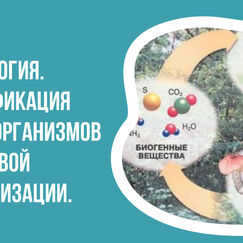
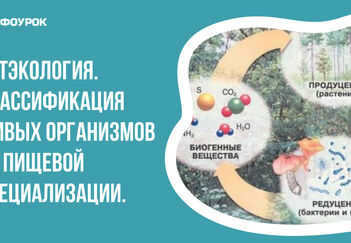
Outecology. Categorization of living creatures based on their dietary habits
Breakdown of the presentation into individual slides:

Slide 2: The solar system – An arrangement of celestial bodies consisting of the Sun, the central star, and various other objects in space that revolve around it. This system was created through the gravitational collapse of a cloud made up of gas and dust approximately 4.57 billion years ago.
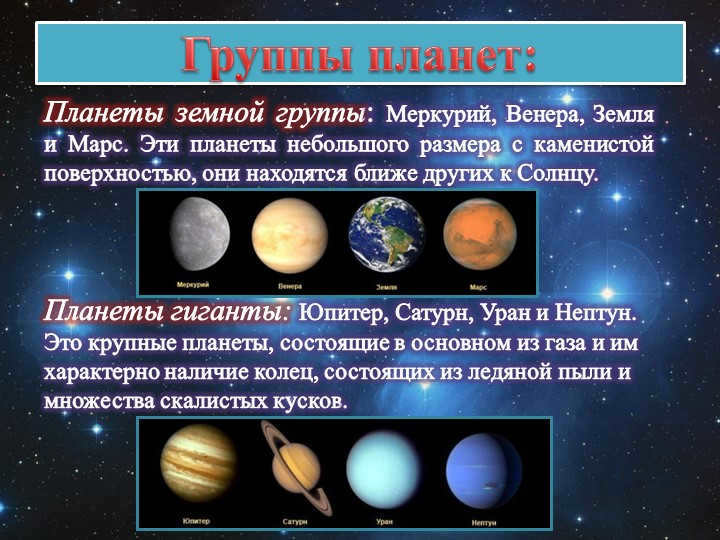
Slide 3: Classification of planets:
Planets in the Earth group include Mercury, Venus, Earth, and Mars. These planets have relatively small sizes and rocky surfaces, and they are located closer to the Sun.
The giant planets, on the other hand, consist of Jupiter, Saturn, Uranus, and Neptune. These planets are significantly larger in size and primarily composed of gas. They are also known for their distinctive ring systems composed of icy dust particles and numerous rocky fragments.
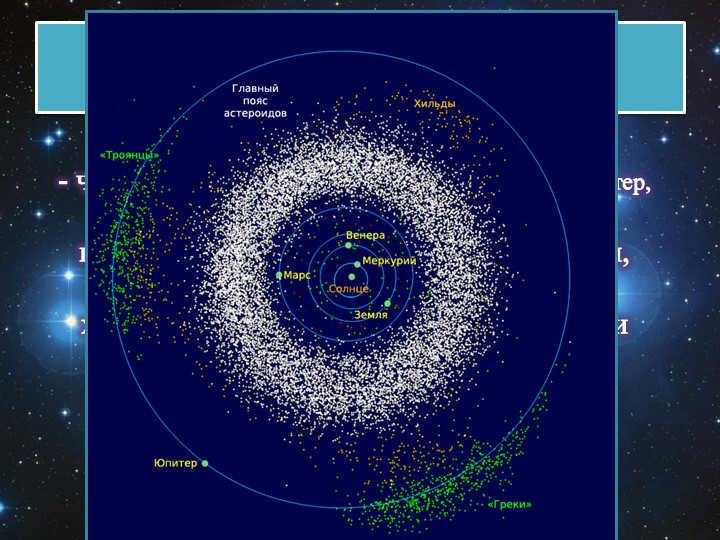
On Slide 4, we have the giant planets.
– These are the four planets in our solar system (Jupiter, Saturn, Uranus, and Neptune) that are situated beyond the asteroid belt. These planets, with their shared physical traits, are also known as the outer planets.
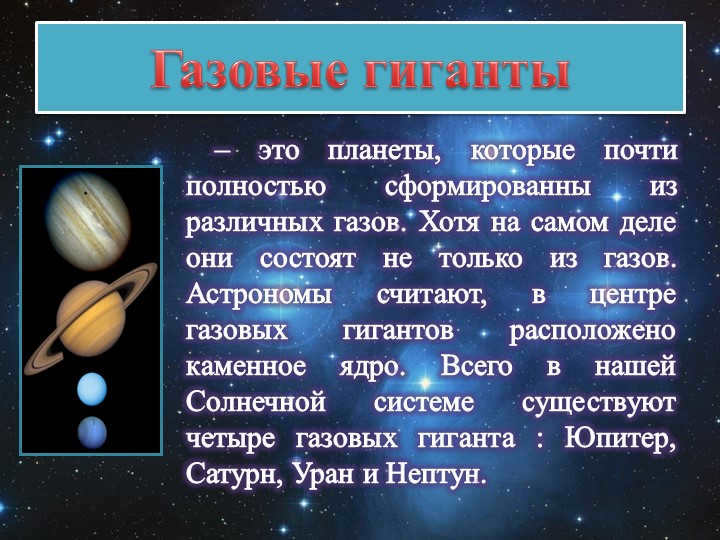

Gas giants, also known as giant planets, are celestial bodies that primarily consist of various gases. However, it is important to note that they are not solely composed of gases. Scientists theorize that gas giants have a solid rocky core located at their center. Within our solar system, there exist a total of four gas giants: Jupiter, Saturn, Uranus, and Neptune.
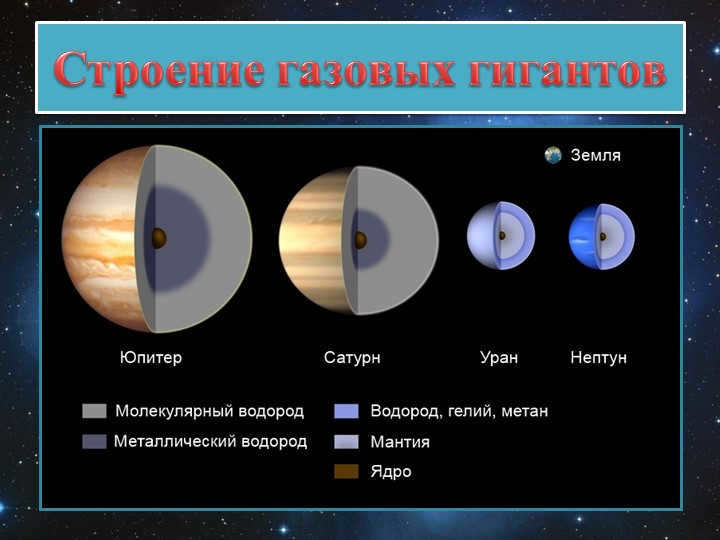
Slide 7
As per the International Astronomical Union, which establishes definitions for planetary science, a gas giant planet is a celestial object that:
is located at a considerable distance from the Sun;
possesses numerous satellites;
exhibits powerful magnetic fields;
displays some type of ring structure.
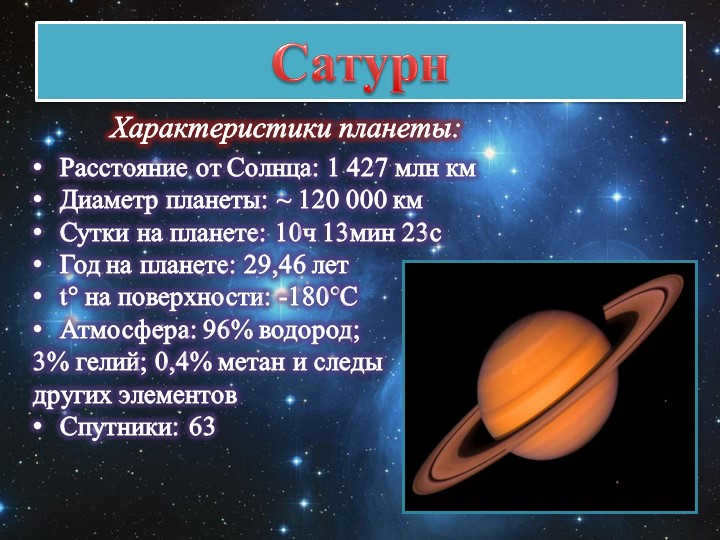
Slide number 8 features the planet Saturn, which is known for its unique characteristics. This magnificent celestial body is located at a distance of approximately 1,427 million kilometers from the Sun. With a diameter of around 120,000 kilometers, Saturn is one of the largest planets in our solar system. A day on Saturn lasts for 10 hours, 13 minutes, and 23 seconds, while a year on this planet is equivalent to 29.46 Earth years. The surface temperature of Saturn is a chilling -180 degrees Celsius. Its atmosphere is composed of 96% hydrogen, 3% helium, 0.4% methane, and traces of other elements. Additionally, Saturn boasts an impressive number of satellites, with a total of 63 orbiting around it.
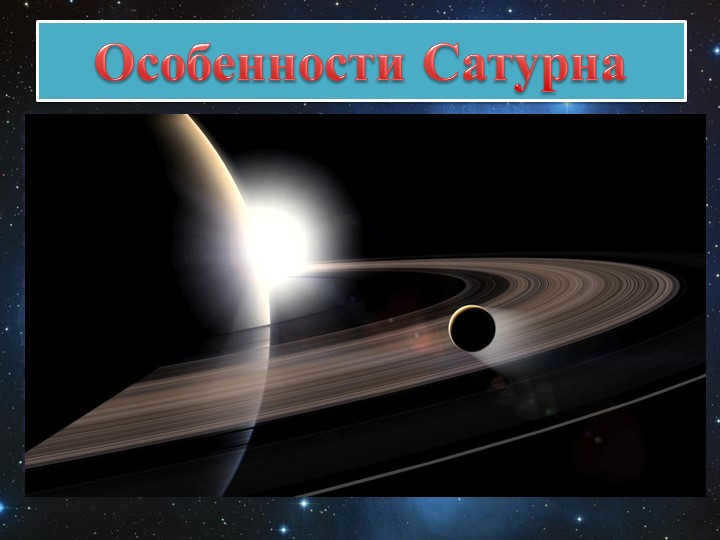
There are 9 notable characteristics of Saturn.
One of the most prominent features is its massive ring system. Spanning nearly 115,000 kilometers wide and approximately 5 kilometers thick, these formations are composed of particles, some of which are several tens of meters in size. These particles are made up of a combination of ice, iron oxide, and rocks.
In addition to its ring system, Saturn is also home to a significant number of natural satellites, boasting around 60 in total. The largest of these satellites is Titan, which has a radius exceeding 2.5 thousand kilometers.
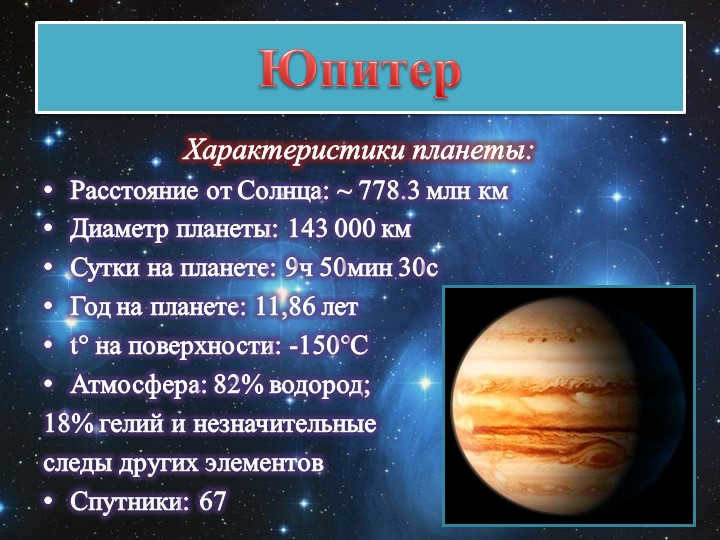
Slide 10: Jupiter
Characteristics of Jupiter:
The distance between Jupiter and the Sun is approximately 778.3 million kilometers.
The planet has a diameter of 143,000 kilometers.
A day on Jupiter lasts for 9 hours, 50 minutes, and 30 seconds.
Jupiter’s year is equal to 11.86 Earth years.
The surface temperature on Jupiter is -150 degrees Celsius.
Jupiter’s atmosphere consists of 82% hydrogen, 18% helium, and traces of other elements.
Jupiter has 67 satellites.
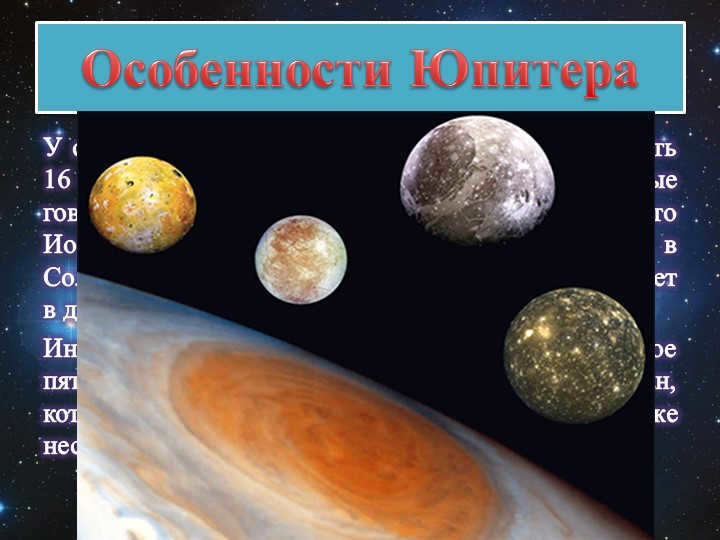

Slide 11: Jupiter, the largest planet in our solar system, is home to 16 natural satellites. Among them are Io, Ganymede, Callisto, and Europa, which were first observed by Galileo using a telescope. Out of these, Ganymede is the largest satellite in the solar system, even though it has a smaller diameter compared to Saturn’s moon Titan.
One of the intriguing features of Jupiter is the Great Red Spot, which scientists believe to be a massive hurricane that has been spinning at speeds exceeding 300 kilometers per hour for centuries.
Characteristics of Jupiter
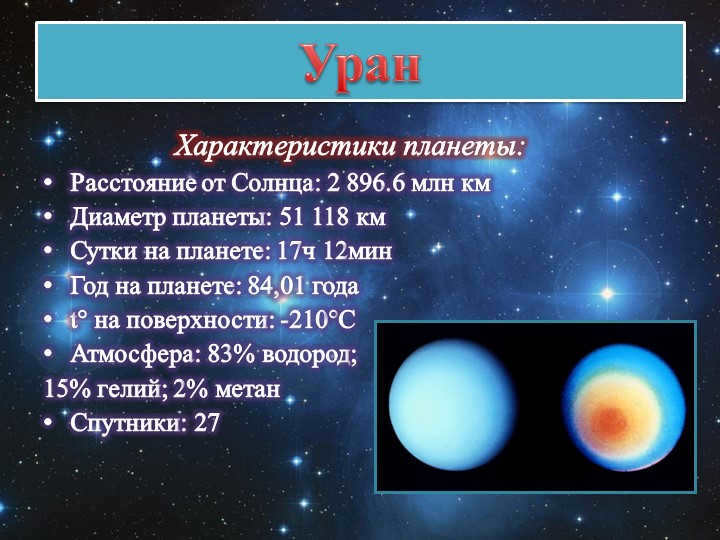
On slide 12, we have Uranus, a planet with the following characteristics:
It is located at a distance of 2,896.6 million kilometers from the Sun.
The diameter of the planet is 51,118 km.
A day on Uranus lasts for 17 hours and 12 minutes.
One year on Uranus is equivalent to 84.01 Earth years.
The surface temperature on Uranus is a chilling -210 degrees Celsius.
Its atmosphere is composed of 83% hydrogen, 15% helium, and 2% methane.
Uranus has a total of 27 satellites.
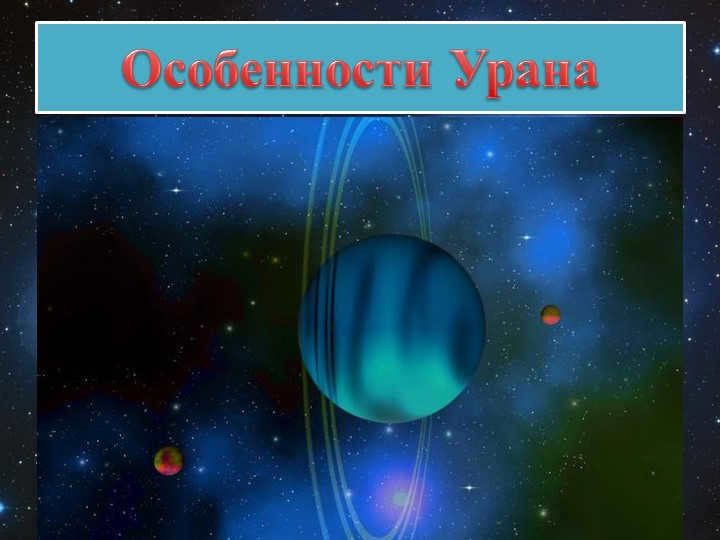

Slide 13 Uranus, akin to its counterparts, possesses its own set of rings, which were confirmed to exist by the Voyager 2 spacecraft.
Uranus houses 4 large moons: Titania, Oberon, Ariel, Umbriel, which likely consist of a crust, core, and mantle. The size of Uranus’ planetary system is also uncommonly small.
Unlike any other planet in the solar system, Uranus has an axial tilt exceeding 90 degrees, giving it the appearance of being “lying on its side”.
Distinctive Characteristics of Uranus
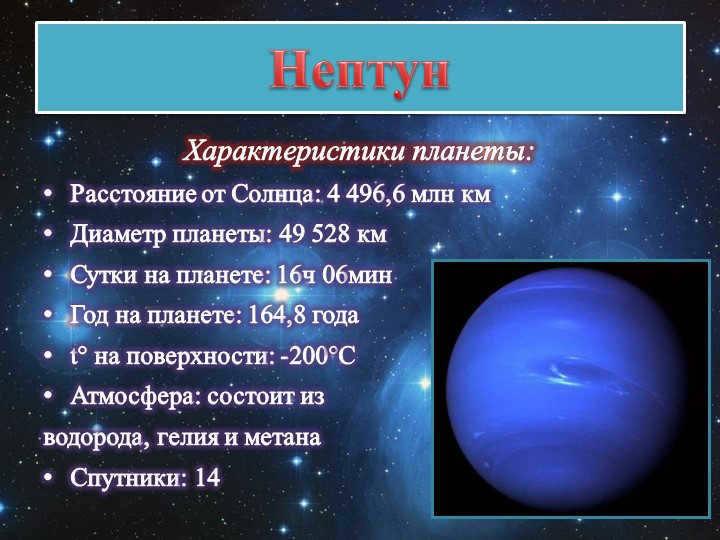
Neptune’s 14th slide provides an overview of the planet’s characteristics. It is located at a distance of 4,496.6 million kilometers from the Sun and has a diameter of 49,528 km. A day on Neptune lasts for 16 hours and 6 minutes, while a year on the planet is equivalent to 164.8 Earth years. The surface temperature of Neptune reaches as low as -200 degrees Celsius. The planet’s atmosphere primarily consists of hydrogen, helium, and methane. Neptune also has 14 satellites orbiting around it.
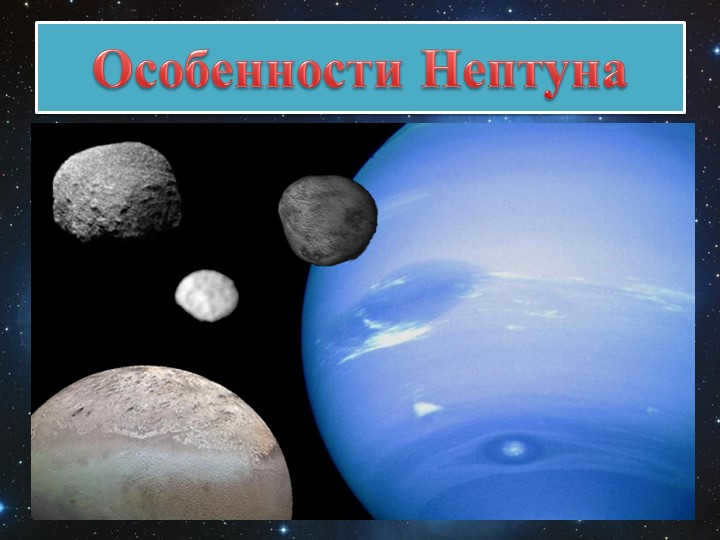
Neptune, similar to Uranus, is an unusual planet composed mostly of gas, with a relatively large solid core compared to its overall mass.
Neptune’s atmosphere is known for its heightened activity, with powerful winds and long-lasting formations of large spots. One notable example is the Great Dark Spot, which is equivalent in size to the planet Earth.
Similarly to the rings of Uranus, Neptune’s rings are thin and dark, believed to be composed of a combination of ice and an unidentified dark substance.
Triton, Neptune’s largest moon, ranks among the largest moons in the entire solar system.
Distinctive characteristics of Neptune
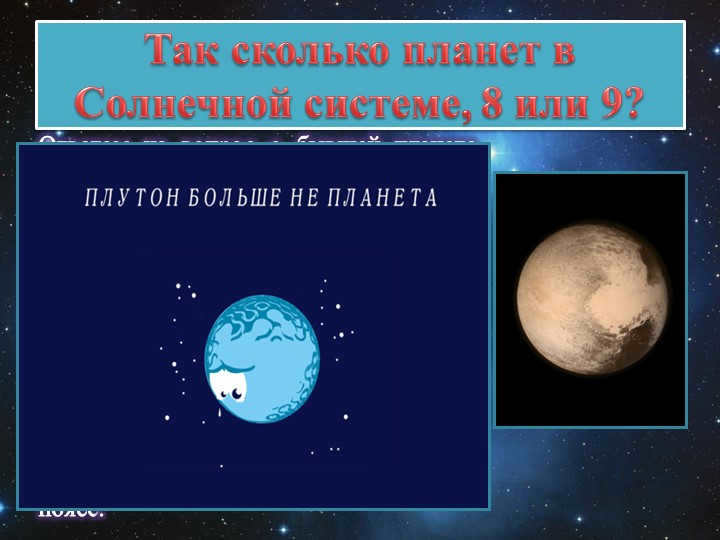

There is a debate about how many planets are in the solar system, with some saying there are 8 and others saying there are 9. The planet that is often referred to as the “former planet” is Neptune.
However, the answer to the question about the former planet of the solar system is actually Pluto. Pluto used to be known as the smallest planet in the Solar System and was considered the ninth planet from the Sun. However, it is now classified as a dwarf planet.
Pluto is smaller than the other planets, but it still orbits the Sun just like the others. It is located in the Kuiper Belt, which is a region of the solar system that contains thousands of small icy objects similar to Pluto.
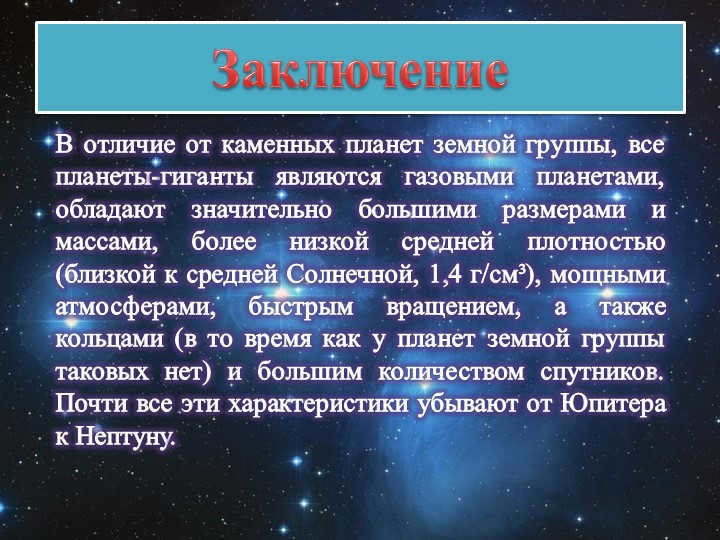

Slide 17 Conclusion
Unlike the rocky planets in the Earth group, all giant planets belong to the gas planet category. They have significantly larger sizes and masses, lower average densities (similar to the average density of the sun, which is 1.4 g/cm³), strong atmospheres, rapid rotations, and rings (unlike the Earth group planets, which lack rings) as well as a large number of satellites. These characteristics generally decrease from Jupiter to Neptune.
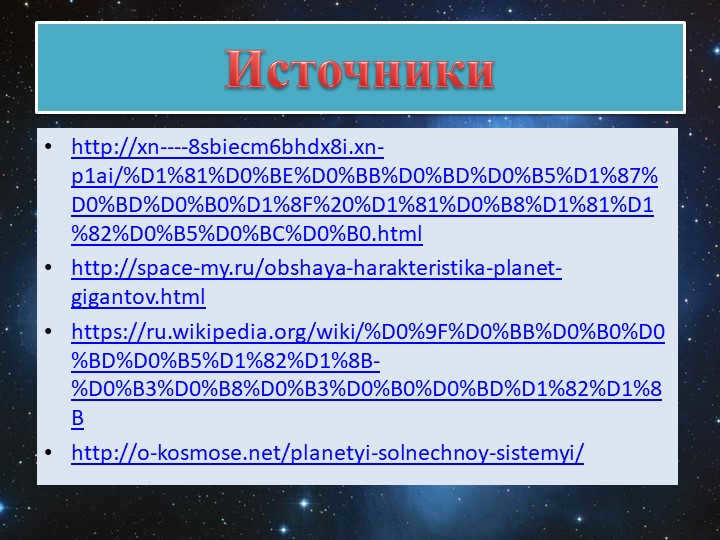

There are 18 slides that provide information about planets. You can find more details at the following sources:
2. http://space-my.ru/obshaya-harakteristika-planet-gigantov.html
4. http://o-kosmose.net/planetyi-solnechnoy-sistemyi/
Brief overview of the document:
Lesson plan scheme on the subject:
"The Planets of the Solar System".
Objective: To form a general understanding of the characteristics of planets in nature.
To promote cognitive activity among students.
To instill a sense of responsibility for our planet and the Universe as a whole.
1. Introduction.
2. Inspiration.
The Solar System consists of various celestial bodies, including planets and their satellites, dwarf planets, comets, asteroids, meteors, and meteorites. These objects are all held together by the gravitational force exerted by the Sun. The planets are the main inhabitants of the solar system, constantly moving and exploring the vastness of the universe. They are the most massive objects orbiting the Sun. To give you an idea of their distances, let’s take the Earth’s distance from the Sun, which is about 150 million kilometers, as a unit of measurement. The most distant planet in our solar system is about 40 units away, equivalent to a staggering 6 billion kilometers!
The planets in the Solar System can be divided into two main groups: the terrestrial planets, which include Mercury, Venus, Mars, and the gas giants, Jupiter, Saturn, Uranus, and Neptune. These groups are named based on their similarities or differences to our home planet Earth. Now let’s take a closer look at the terrestrial planets and explore their similarities and unique characteristics. (Slides 2,3).
3. Exploring a new subject.
Planetary Characteristics:
- Distance from the sun to each planet
- Diameter of each planet
- Relief and color of each planet
- Appearance in the night sky
- Composition of each planet’s atmosphere
- Surface temperature of each planet
- Rotation on each planet’s axis
- Revolution around the sun
- Presence and description of major satellites
1) Mercury. (Slides 4,5)
Mercury, the initial planet in our solar system, has an average distance from the Sun of 0.387 astronomical units, equivalent to 58 million kilometers. The planet orbits the Sun in a strongly elongated elliptical path, with its perihelion (the closest point to the Sun) at a distance of 45.9 million km, and its aphelion (the farthest point from the Sun) at a distance of 69.7 million km. The distance between Mercury and Earth varies from 82 to 217 million kilometers.
Mercury is the smallest planet among the Earth group, measuring only 2 times smaller than Earth. Its radius is a mere 2439 km.
The planet’s collision with a massive asteroid caused it to undergo significant changes.
During the most optimal circumstances, the planet can be observed during the early morning hours in the eastern sky, just before sunrise, or in the western sky, right after sunset. Because of this, in ancient times, people often mistook Mercury for two separate celestial bodies, one appearing in the morning and the other in the evening. In terms of its appearance, Mercury closely resembles the Moon and also experiences phases, transitioning from a thin crescent shape to a fully illuminated circle.
Mercury’s atmosphere is unique and primarily composed of oxygen, sodium, and helium. Due to the planet’s extreme heat, the atmosphere’s atoms are continually escaping into space, yet they are also consistently replenished by atoms carried in by the solar wind. Given the significant rarefaction, the characterization of Mercury’s atmosphere is somewhat subjective, as the atmospheric pressure on Mercury is 500,000,000,000,000 times lower than that of Earth, making it comparable to a vacuum.
To an ordinary vacuum.
Due to its close proximity to the Sun, Mercury’s surface receives a significant amount of the Sun’s radiation, approximately 10 times more than the Earth. As a result, the temperature on Mercury’s surface is extremely high, reaching up to 467°C. However, during the nighttime, temperatures drop significantly to minus 183°C.
Mercury has an average orbital speed of 47.9 km/sec and completes a full revolution around the Sun in 87.97 Earth days. In terms of its own rotation, Mercury rotates at a relatively slow pace. In fact, for every two revolutions around the Sun, Mercury completes approximately three rotations, which is equivalent to 58.65 Earth days.
2) Venus. (Slides 6-9).
Venus, the second most distant planet in our solar system, is also the third brightest object in the sky, surpassed only by the Sun and the Moon. Its extraordinary brilliance has led to its association with the goddess of love and beauty in Roman mythology. Venus, known to mankind since ancient times, is an inner planet with an average distance from the Sun of 108 million kilometers.
In terms of size, Venus is relatively close to Earth. The planet has a radius of 6051.8 km.
Venus’s terrain is characterized by vast plains and mountain chains. The planet also experiences volcanic activity, resulting in the formation of numerous craters.
The discovery of the atmosphere on Venus was made by M.V. Lomonosov on June 6, 1761. It is primarily composed of carbon dioxide (96%) and nitrogen (almost 4%). Small amounts of water vapor and oxygen are also present, constituting 0.02% and 0.1% respectively. The surface temperature of Venus is approximately 475 °C, which is even higher than that of Mercury, despite being twice as close to the Sun. This elevated temperature on Venus is a result of the greenhouse effect caused by its dense carbon dioxide atmosphere, making the existence of liquid water on its surface highly improbable.
Venus has a unique rotational feature compared to most other planets in the solar system. It rotates on its axis in the opposite direction. In addition to this, Venus also holds two cosmic records. Firstly, it has the densest atmosphere among the Earth group of planets. Secondly, it has the slowest rotation, completing one revolution in 243 days. This means that a solar day on Venus is equivalent to 116.8 Earth days.
3) Earth. (Slides 10-17).
The Earth is positioned as the third celestial body in the Solar System from the Sun. In terms of its shape, the Earth closely resembles an ellipsoid, being more compressed at the poles and elongated at the equatorial region. The Earth has a mean radius of 6371.032 km, a polar radius of 6356.777 km, and an equatorial radius of 6378.160 km. Its mass is estimated to be 5.976*10^24 kg. The average density of the Earth is approximately 5518 kg/m^3. The total surface area of the Earth is roughly 510.2 million km^2, with the world’s oceans accounting for around 70.8% of this area. The average depth of the Earth’s oceans is about 3.8 km, while the deepest point, the Mariana Trench in the Pacific Ocean, reaches a depth of 11.022 km. The total volume of water on Earth is estimated to be 1370 million km^3, with an average salinity of 35 g/l. The landmass covers 29.2% of the Earth’s surface, forming six continents and numerous islands. The average elevation above sea level is 875 meters, with the highest peak, Mt. Everest in the Himalayas, reaching a height of 8848 meters. Mountains cover more than one-third of the Earth’s land surface, while deserts cover approximately 20%, savannahs and sparse forests cover about 20%, forests cover around 30%, and glaciers cover over 10%. Agricultural land occupies over 10% of the Earth’s land area. The Earth has a solitary natural satellite, the Moon. Due to its exceptional and possibly unparalleled natural conditions, the Earth became the birthplace and haven for organic life in the Universe. According to current cosmogonic theories, the planet formed approximately 4.6 to 4.7 billion years ago from a protoplanetary cloud captured by the gravitational force of the Sun. It took 100-200 million years for the initial and most ancient rocks to form. Around 3.5 billion years ago, the ideal conditions for life’s emergence came into existence. The species Homo sapiens (modern humans) appeared approximately half a million years ago, and the development of the modern human type is attributed to the period when the first glacier retreated, approximately 40 thousand years ago. Movement. Similar to other planets, the Earth orbits the Sun in an elliptical trajectory, with an eccentricity of 0.017. The distance between the Earth and the Sun varies at different points along the orbit. On average, this distance is approximately 149.6 million kilometers. During the Earth’s orbit around the Sun, the plane of the Earth’s equator maintains a parallel alignment, resulting in certain parts of the orbit where the northern hemisphere is inclined towards the Sun, while in other parts, the southern hemisphere is inclined towards the Sun. The Earth completes one orbit around the Sun in 365.256 days, with a daily rotation period of 23 hours and 56 minutes. The Earth’s axis of rotation is tilted at an angle of 66.5 degrees to the plane of its orbit around the Sun. Atmosphere.
The atmosphere of Earth is composed of 78% nitrogen and 21% oxygen, with only a small amount of other gases present. This composition is the result of a lengthy process involving geological, chemical, and biological factors. Initially, Earth’s atmosphere may have contained a significant amount of hydrogen, but it eventually escaped. Over time, the interior of the Earth released carbon dioxide and water vapor through degassing. However, the water vapor condensed into oceans, and the carbon dioxide became trapped in carbonate rocks. As a result, nitrogen remained in the atmosphere, and oxygen gradually appeared due to the biosphere’s activities. Even as recent as 600 million years ago, the oxygen levels in the air were about 100 times lower than they are today.
4) Mars. (Slides 18-27)
Mars, the second planet in our solar system, has captured the curiosity of humans for quite some time now. There is a strong desire among us to explore this planet, fueled by the possibility of discovering advanced extraterrestrial life.
The planet Mars got its name from the ancient Roman god of war, due to its distinctive blood-red color caused by the presence of iron oxide in its soil.
Mars is the fourth farthest planet from the Sun and ranks seventh in terms of size among the planets in our Solar System. It can be observed from Earth with the naked eye and is one of the brightest celestial bodies, only surpassed by Venus, the Moon, and the Sun.
Mars is approximately half the size of Earth, with an equatorial radius of 3,396.9 kilometers, which is 53.2% of Earth’s radius. The surface area of Mars is roughly equivalent to the land area on our planet.
Mars is situated at an average distance of 228 million kilometers from the Sun, and it takes approximately 687 Earth days for the planet to complete one orbit around the Sun.
The distance between Mars and Earth varies, with the minimum distance being approximately 55.75 million kilometers and the maximum distance being around 401 million kilometers.
However, the low gravity on Mars causes various challenges. The planet is unable to retain an atmosphere, which is essential for sustaining life. The atmosphere on Mars is very thin and not dense, similar to that of Venus. During the summer, the temperature can reach +20°C during the day, which is relatively suitable for life. However, during winter nights, the temperature drops to -125°C. The thin atmosphere fails to retain heat, resulting in Mars being a cold, waterless desert resembling the Moon more than Earth. Mars is also significantly smaller and lighter than Earth, with nearly half the size and only one-ninth of the mass.
Mars possesses two natural moons, Phobos and Deimos, along with three man-made satellites.
4. Synthesis and consolidation of the material.
Knowledge check.
There are ten questions, each with multiple-choice answers. You must select the correct option and encircle it.
(Students are provided with task sheets).
1. Choose the planets from the Earth group:
A) Mercury, Venus, Mars, Earth
B) Earth, Jupiter, Saturn, Mars.
2) Which planet in the solar system has the shortest year?
a) Earth; b) Mercury; c) Venus.
3) Which planet has the longest day compared to its year?
a) Pluto; b) Mercury; c) Jupiter.
4) Among the terrestrial group planets, which one is closest to Earth?
a) Mars; b) Venus; c) Mercury.

